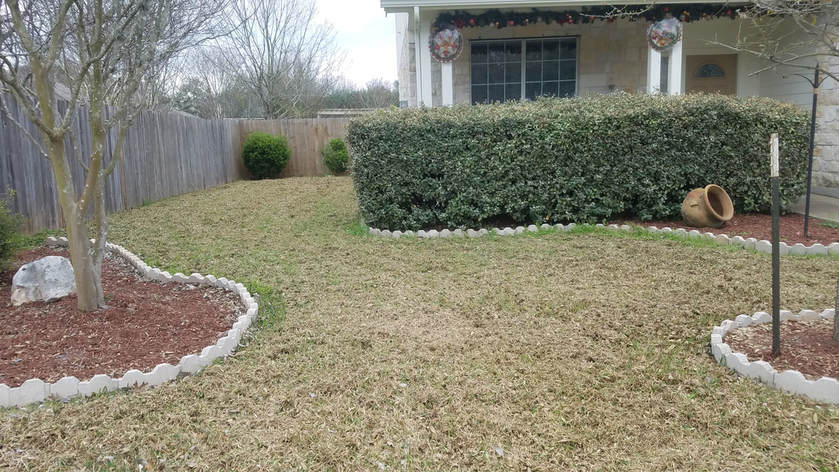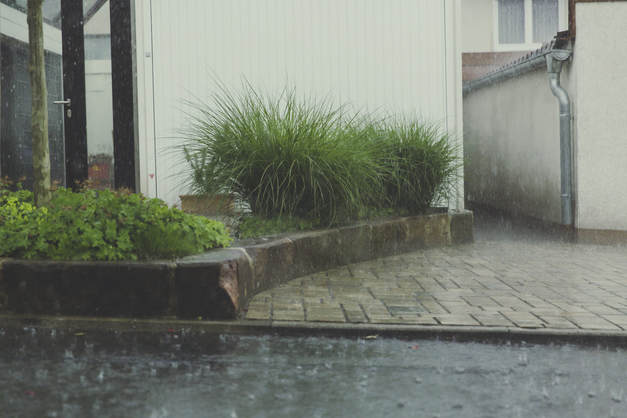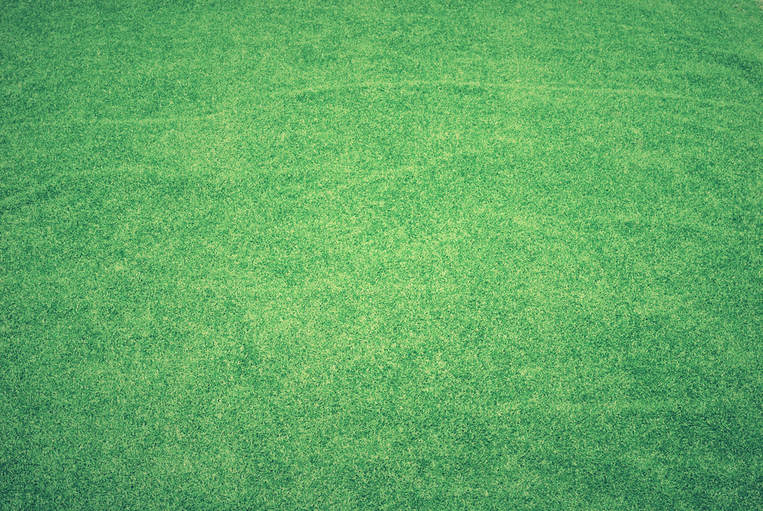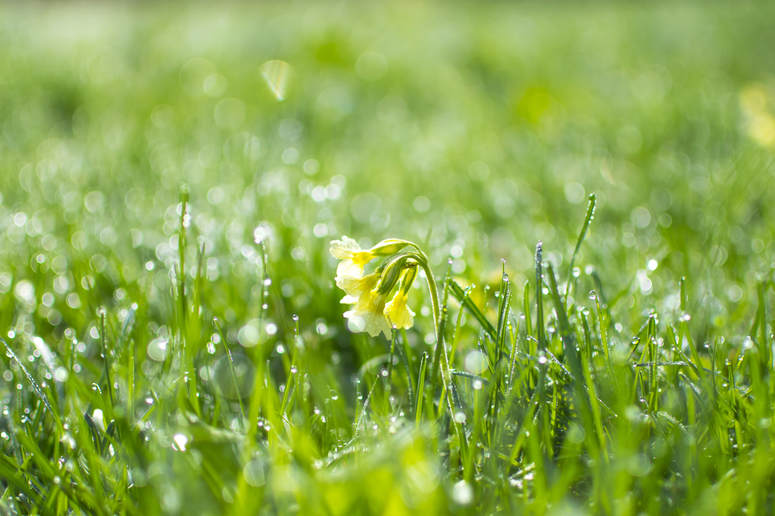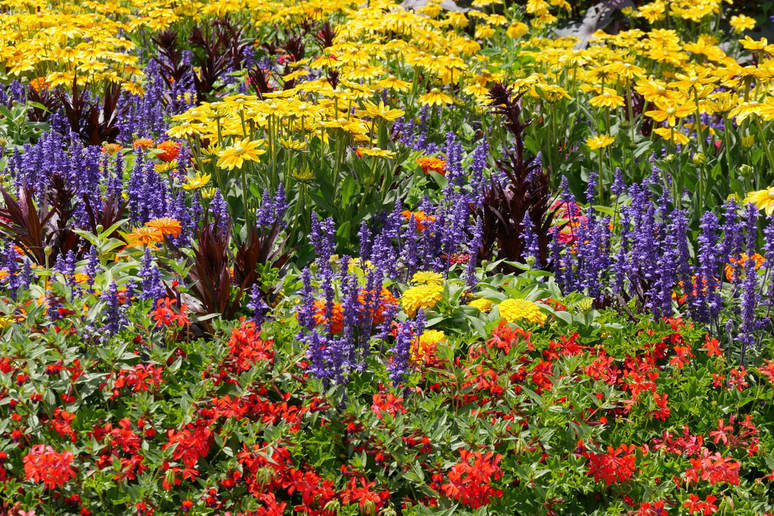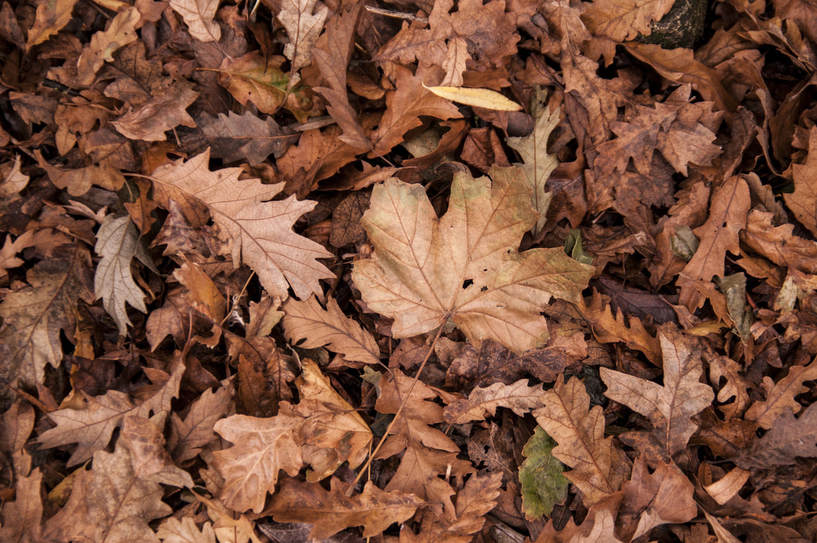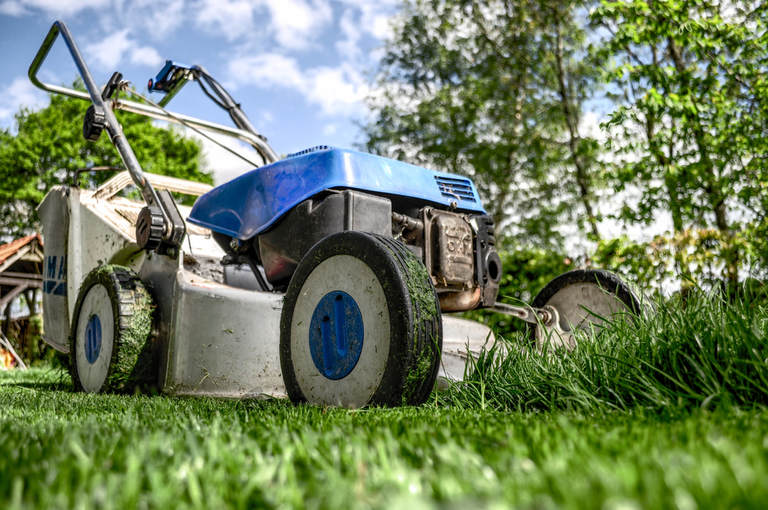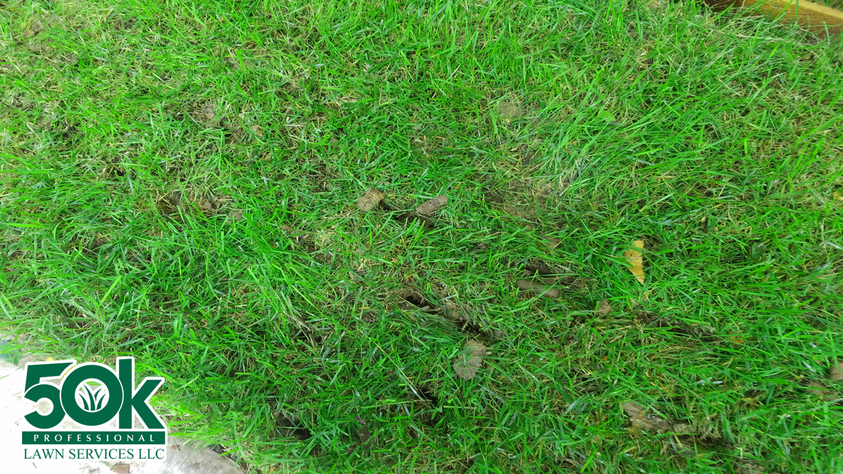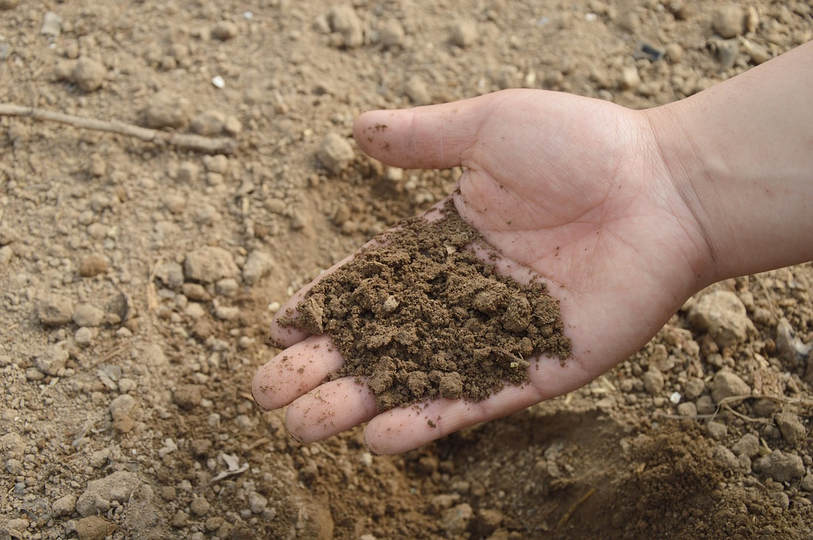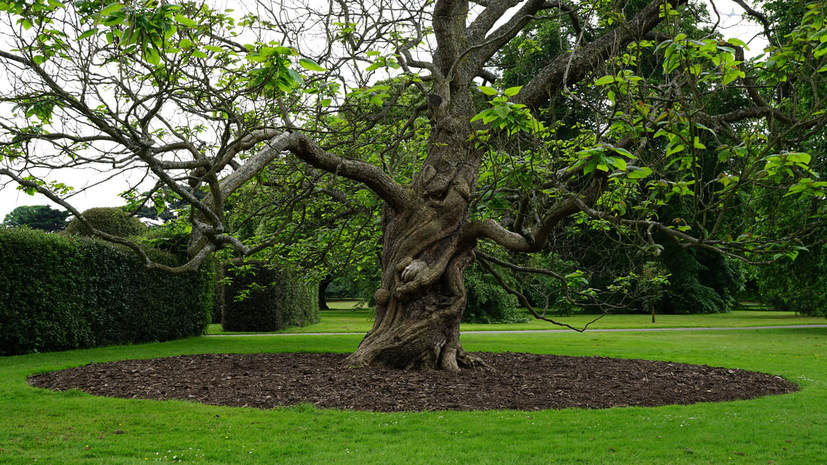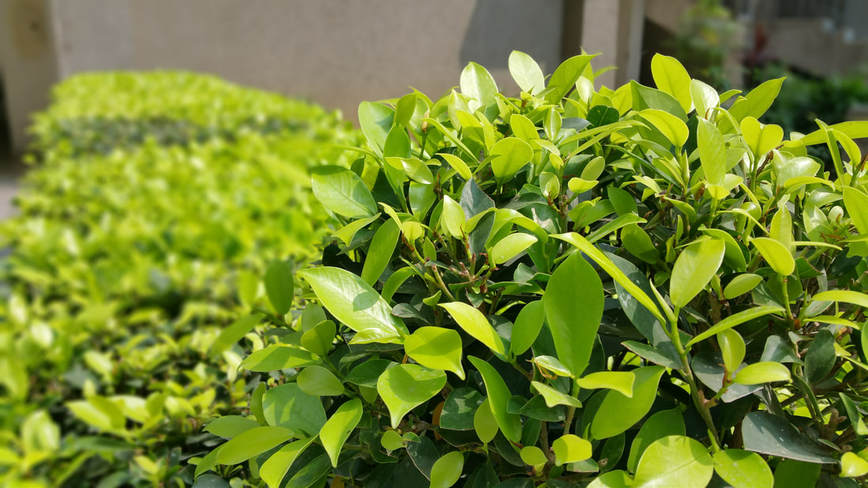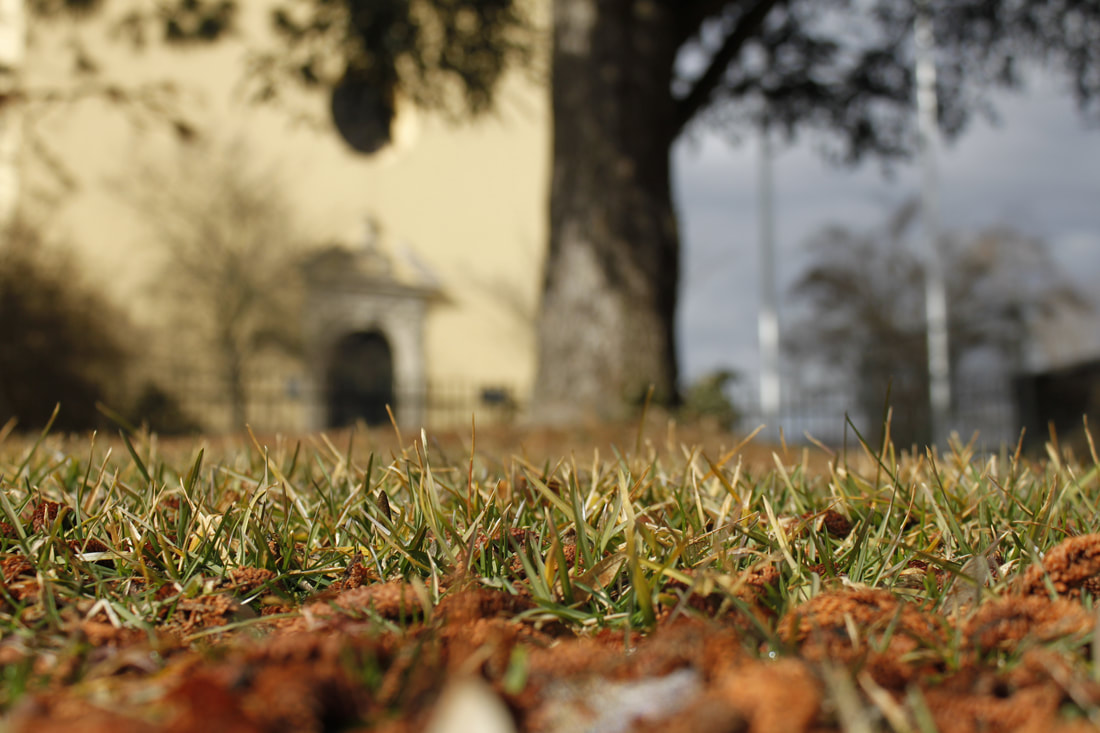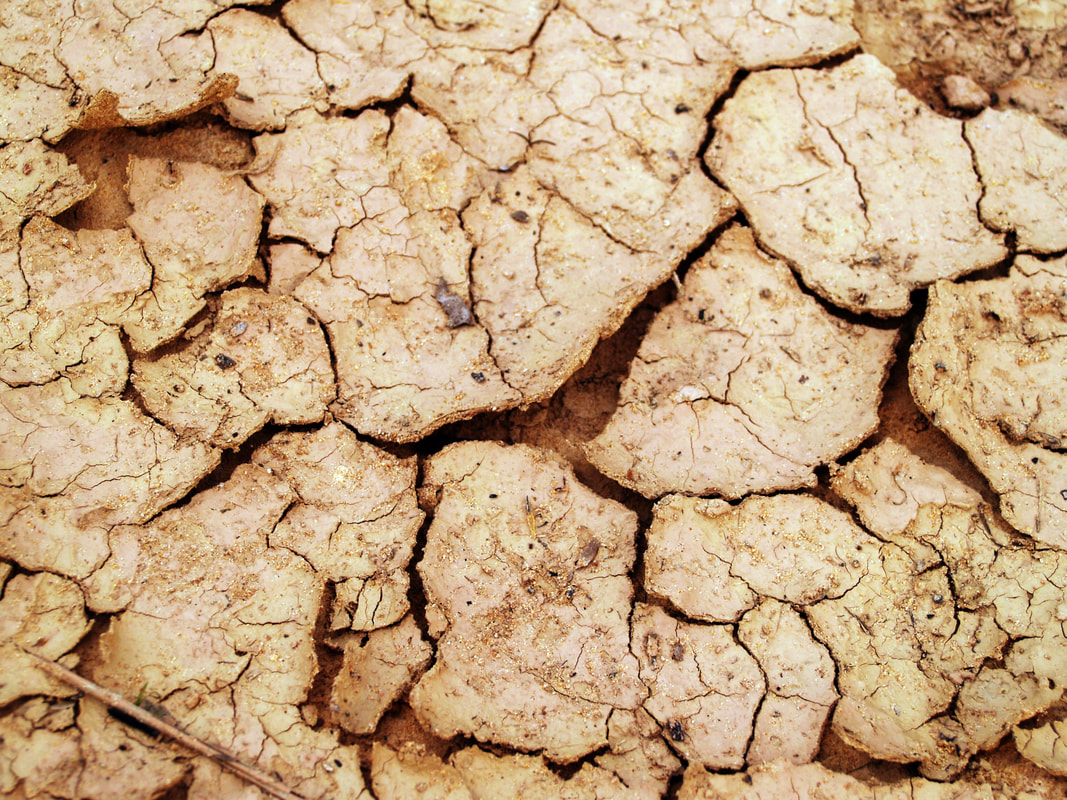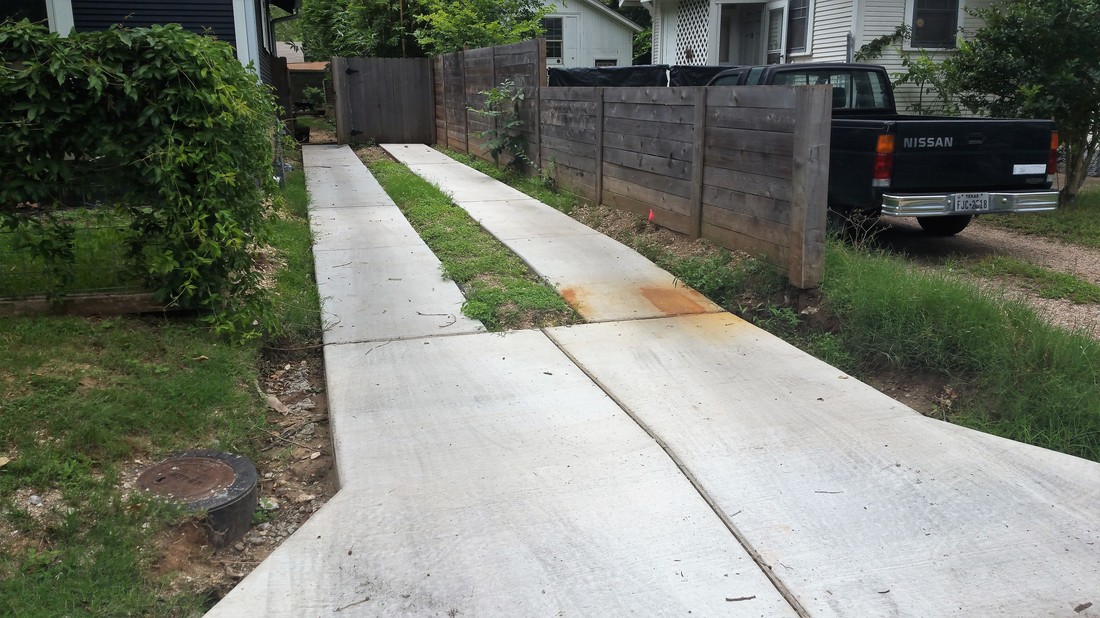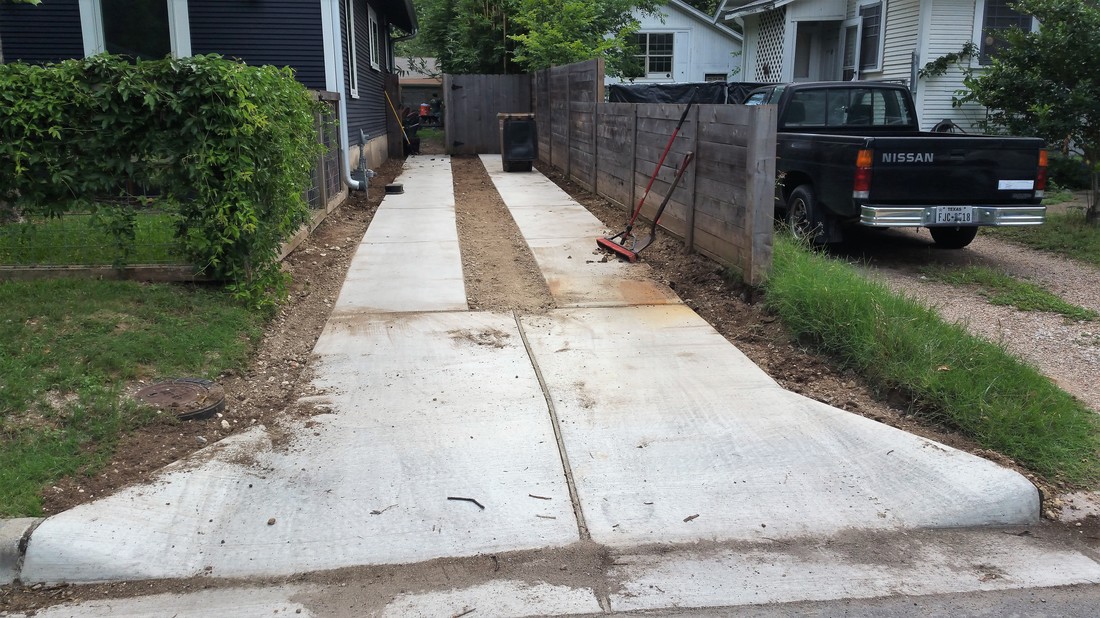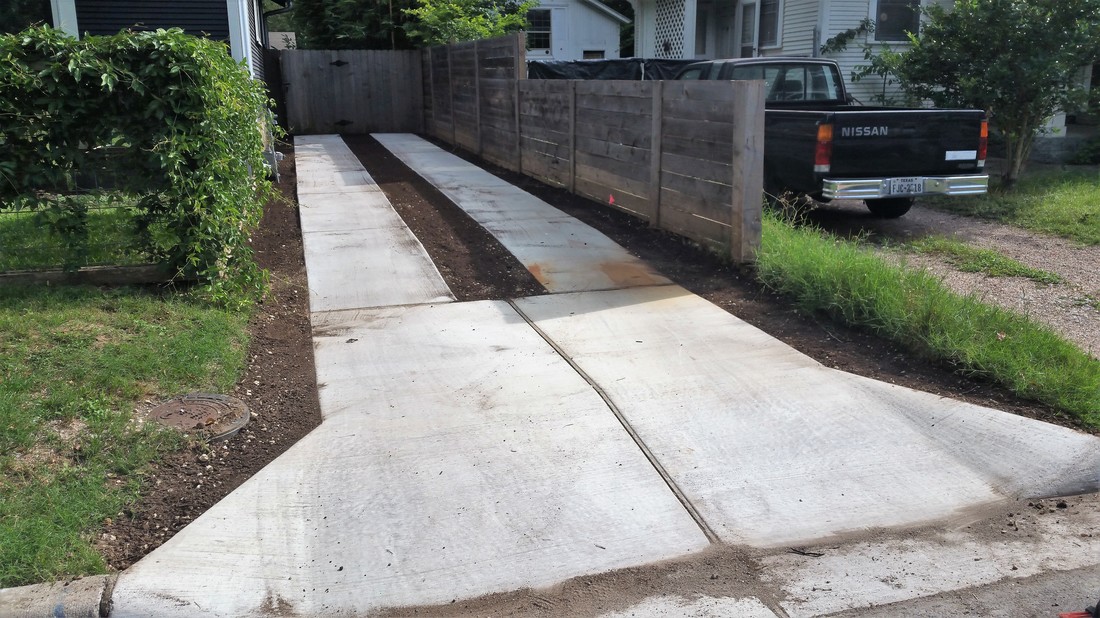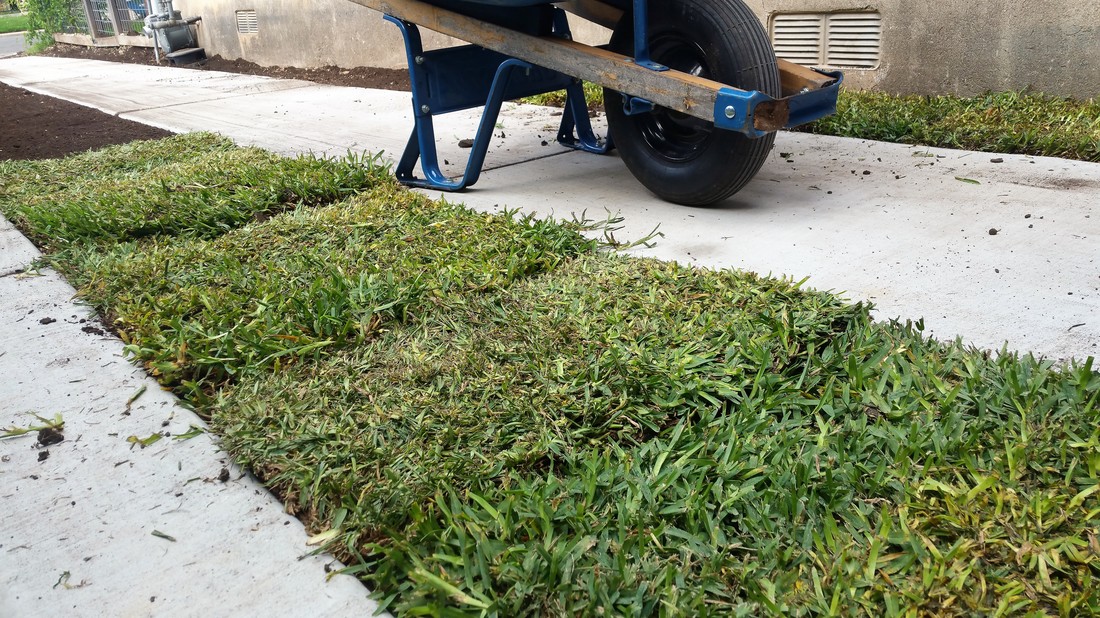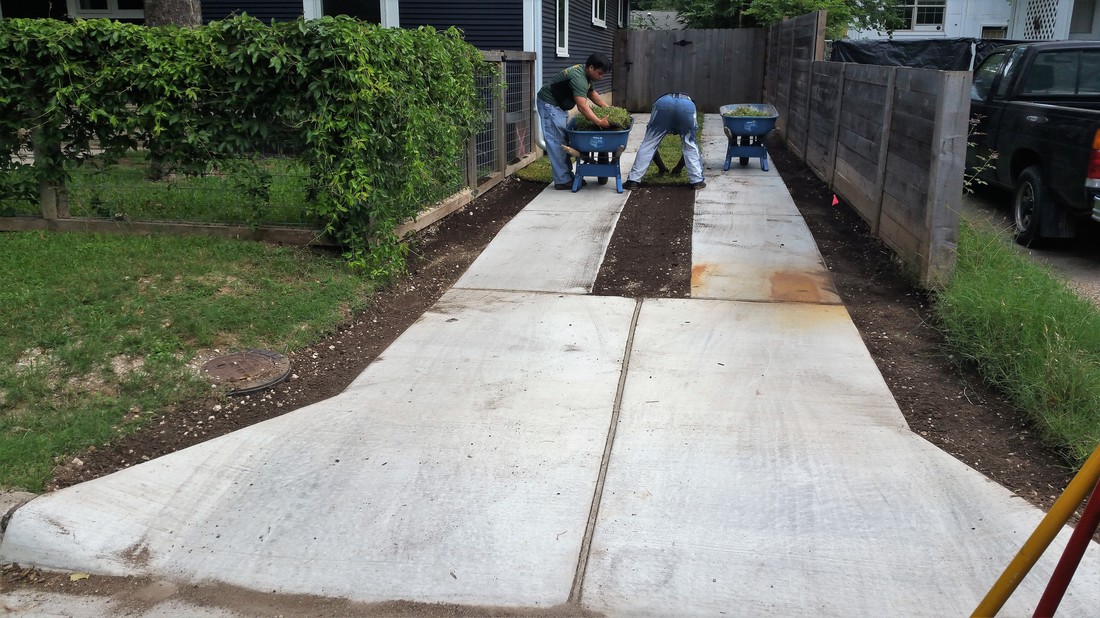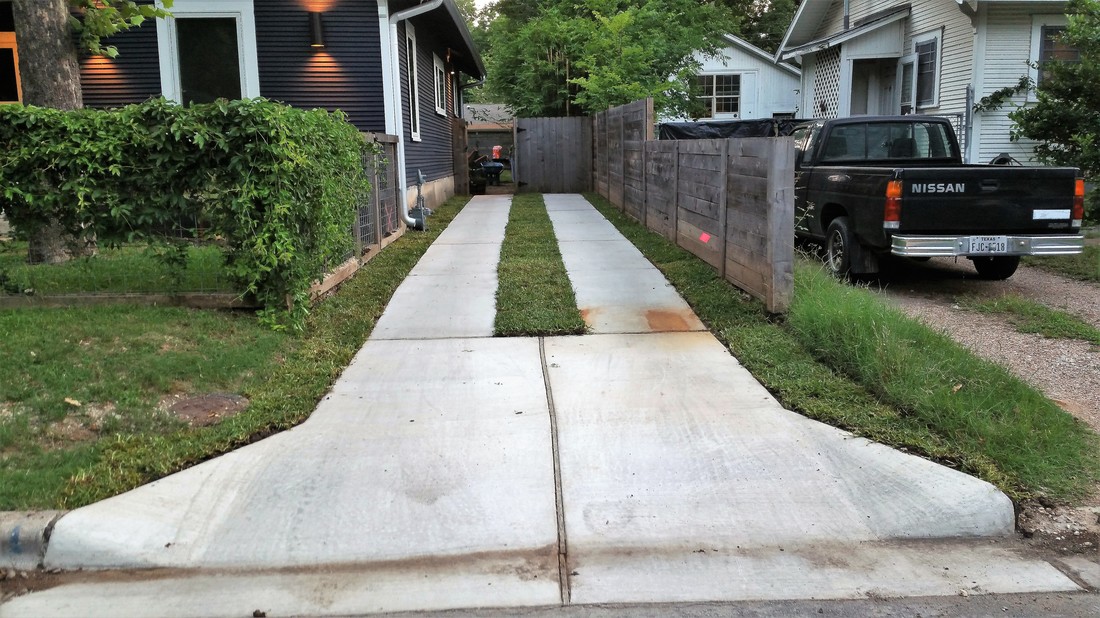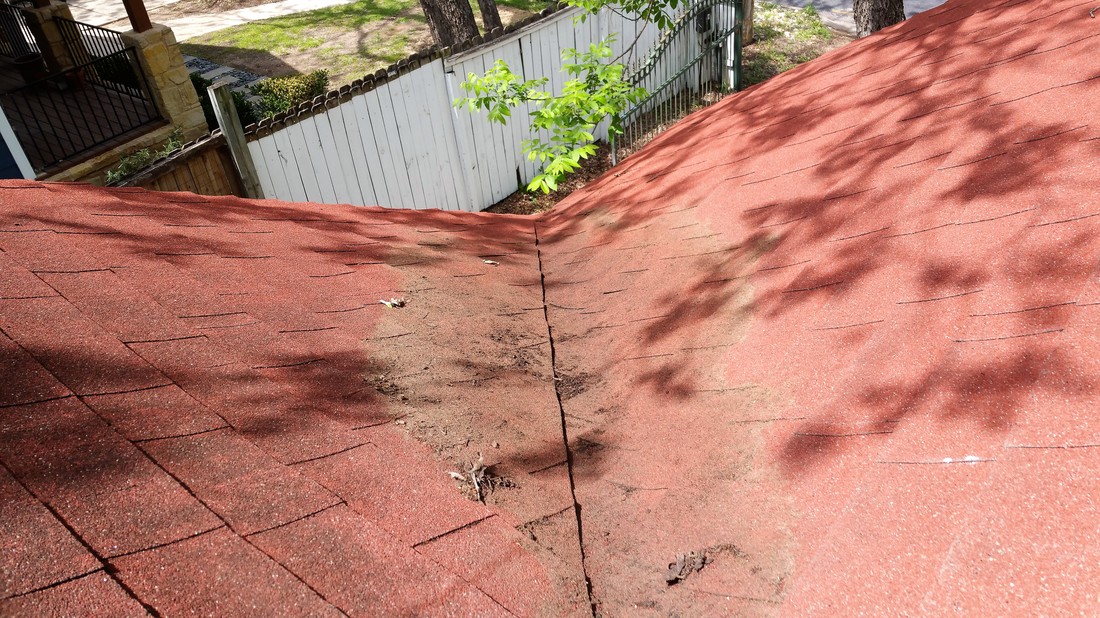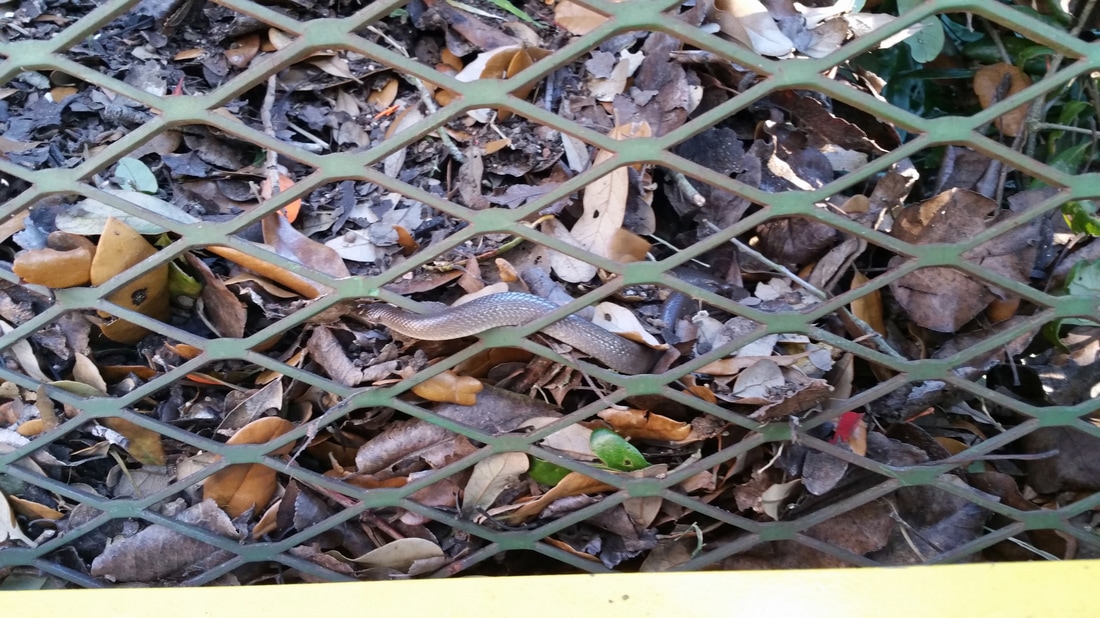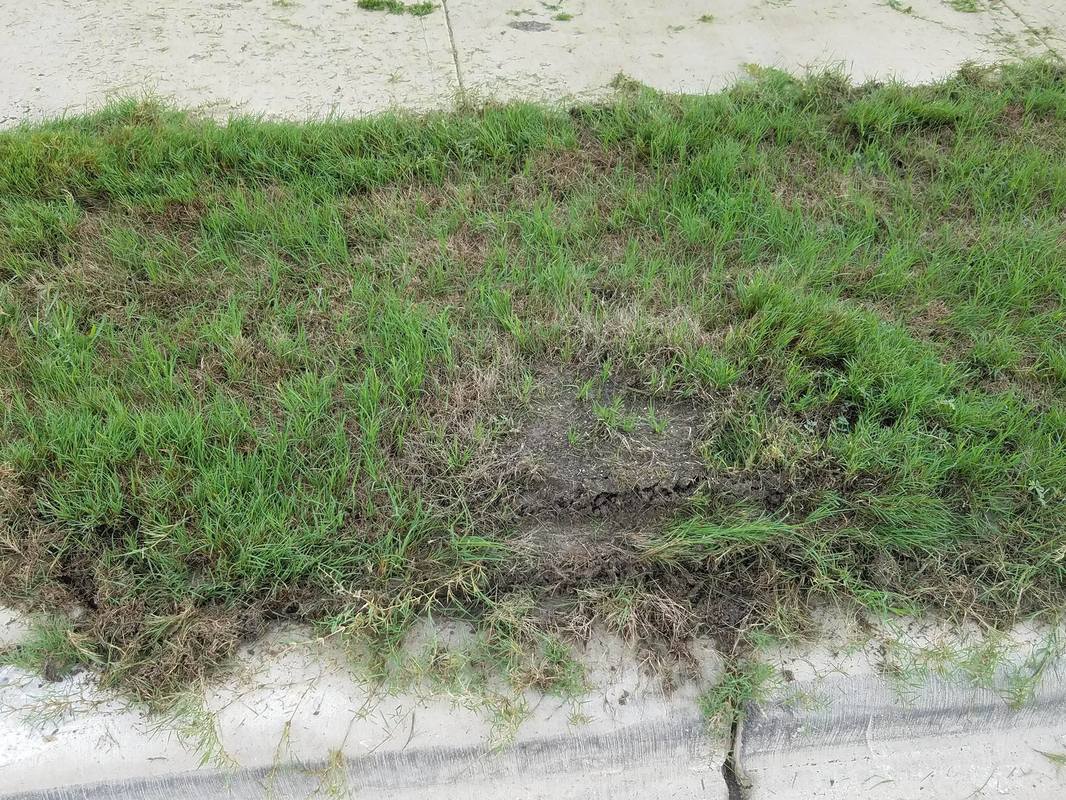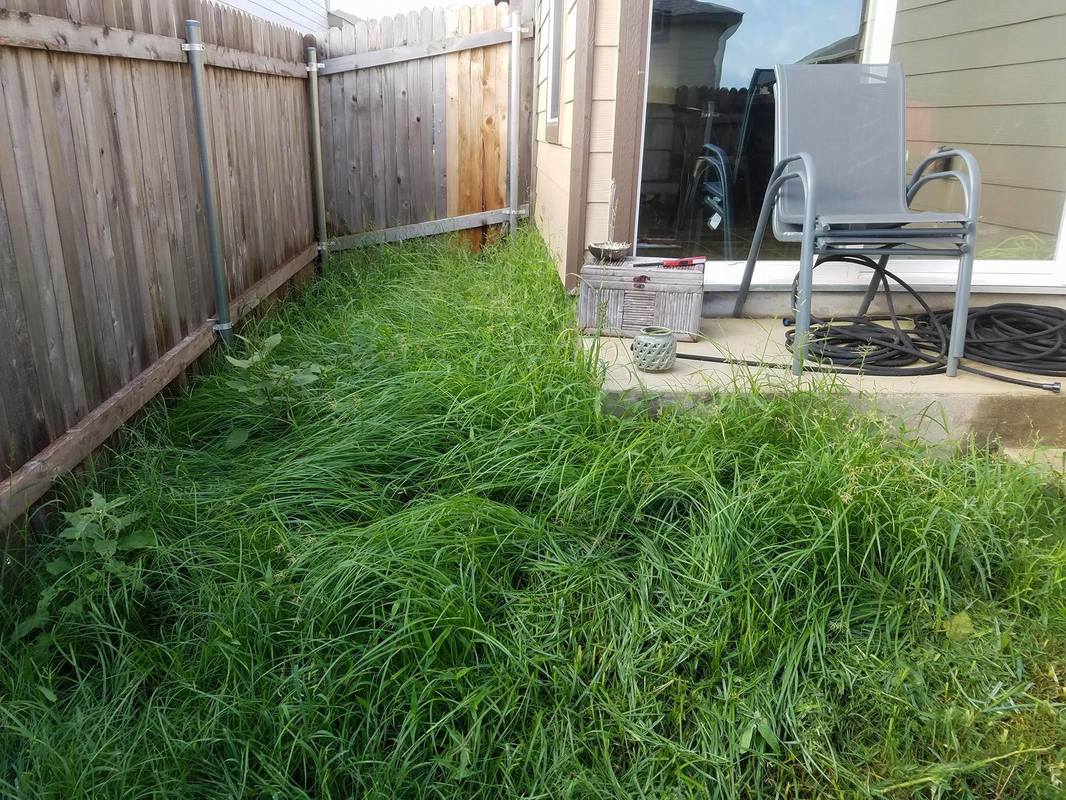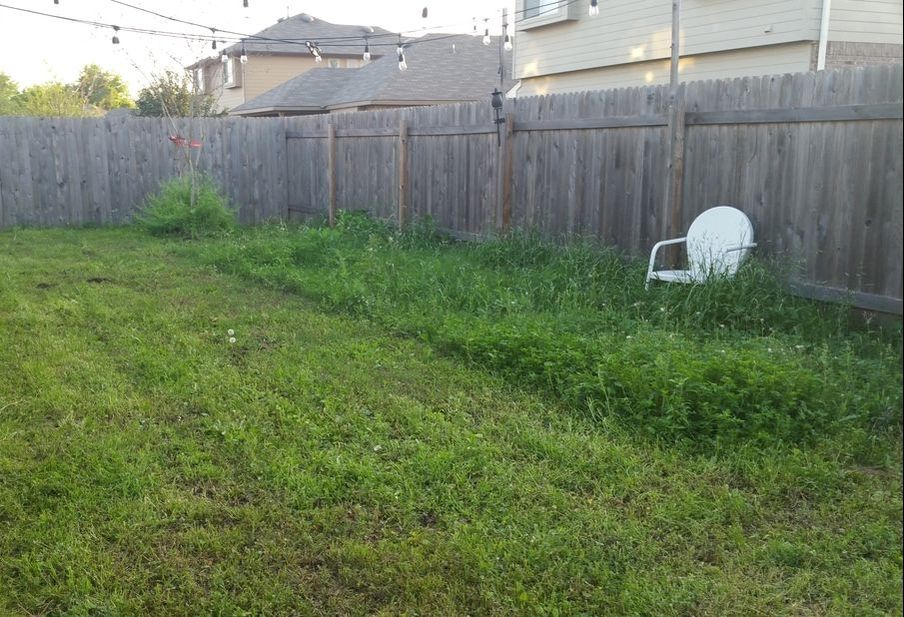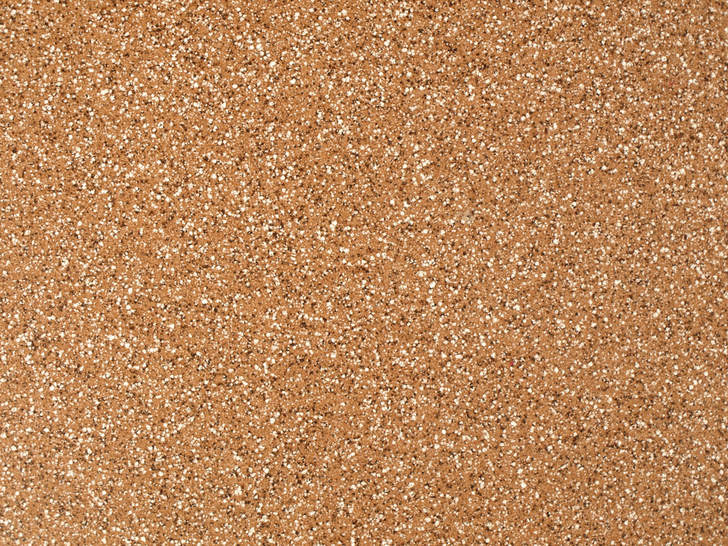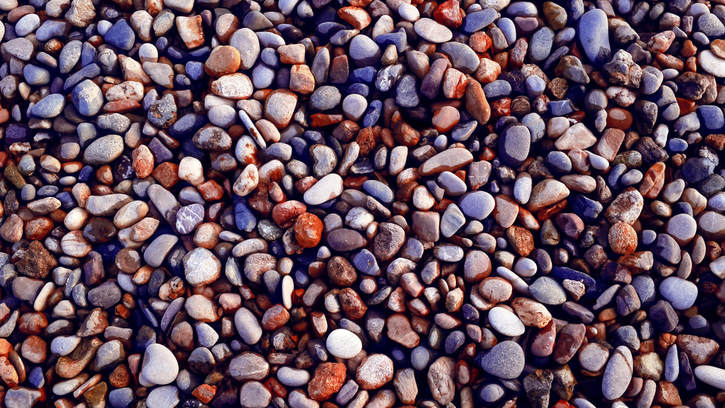|
Now updated to the most current science in 2023!
Debunking the MythContrary to popular belief, mulching the lawn or otherwise leaving grass clippings or leaves on the lawn will NOT increase the thatch layer. Grass clippings and leaves are made up mostly of water and nutrients that can easily be absorbed by the lawn. According to University of Minnesota Extension, "grass clippings decompose rapidly and contribute very little to thatch accumulation." When it comes to leaving leaves on the lawn, Virginia Tech and Virginia State University says, "Mulching the leaves had no undesirable effects on turf quality or color, growth, thatch accumulation, soil pH, weed populations, or disease pressure. While the leaves did not prove to be a substitute for appropriate N fertilization practices, the general assessment was that mulching was overall very positive and economical."Thatch Build-upExcessive thatch build up happens when the lawn produces more organic debris much faster than can be decomposed. According to Penn State University, "parts of grass plants that are the most resistant to decay — stem nodes, crowns, fibers of vascular tissues, and roots — make up the bulk of thatch." Mowing infrequently will contribute to thatch build up. This is because a significant amount of stem tissue gets cut off. As time passes by mowing one overgrown lawn after another, thatch layer naturally thickens as more and more stem nodes, crowns, fibers, and roots collect underneath the lawn. This is the reason why dethatching exists.
Thatch ManagementThatch Management calls for regular lawn maintenance, more frequent and regular weekly mowing, even when you think the grass has not grown yet. This limits the length of the grass to be cut and lowers the amount of organic matters resistant to decay. Mowing higher is also preferred to keep the grass lush and thick. Aerate and Top Dress regularly in Spring to reduce the need for synthetic fertilizer. Avoid the use of high yielding Nitrogen synthetic fertilizer because synthetic nitrates simply kill too many soil microbial life. To get a greener look earlier into the growing season, add Iron instead of Nitrogen. Do not deep water lawns that are compacted. When the root system is restricted, there is no added benefit to watering deeply. Excessive moisture in the soil can simply become a paradise for fungal growth that may eat away the lawns' root system. As the lawn thickens and recovers, you may gradually increase watering intervals and increase the amount of water at every watering time. Reducing the watering time may be needed for lawns with slopes and hills to lessen water runoff and top soil erosion.THE UPDATE New to 2023, the use of Actively Aerated Compost Tea in Thatch ManagementIncorporating actively aerated compost tea into your lawn care regimen offers numerous benefits. Compost tea is a nutrient-rich liquid produced by steeping compost in aerated water. Applying compost tea to dethatched lawns can:
We hope that our little blog post helps you in understanding more about dethatching and thatch. Should you need help with your lawn, please do not hesitate to contact us. We are very eager to help.
2 Comments
Ah, the dreaded rain delay! Lawn Care Providers and Landscapers in Austin have a love-hate relationship with rain. Too little rain causes drought. Too frequent rain creates disruption to virtually all services. This is something the entire industry has to work with. But why would services be disrupted just because of rain in the first place? 1. SafetyIt is simply slippery when wet. Slip and fall accidents can break bones, dislocate shoulders, hips, fingers, and more. Occupational Safety and Health Administration (OSHA) says slip and fall accounts for approximately 25% of all injury claims per year, 17% of disabling injuries, and 15% of accidental deaths. This is on top of the increase likelihood of getting involved in vehicle collisions. According to the U.S. Department of Transportation (DoT) statistics, 22% or 1.2 million crashes every year are weather related. Over a 10-year period, 73% is said to be attributable to wet pavement and 43% is connected to driving when it's rainingrain fall. Working under the rain simply elevates a lot of unnecessary safety issues and problems for lawn care providers and landscapers in Austin. Problems that, in all honesty, are avoidable.2. Labor InefficiencyBecause lawn care providers and landscapers in Austin have to be more cautious of their surroundings, they have to work much slower than when it is dry. This increases the cost of labor way above the budgeted time. "One key example", based to a whitepaper published by Intergraph "is [homeowners] will very often demand the same completion date, despite the added workscope. This may require overtime, second shift work, rework, additional crafts, and many other impacts to the original plan and estimate. This increase in man-hours, constraints, and other resources would impact the cost and schedule." The same DoT report, moreover, shows travel inefficiency increases by as much as 50% when it rains. Since a huge amount of lawn care and landscaping jobs pricing are connected one way or another to labor cost, pricing has to be increased significantly. Nobody wants that to do that.3. Decreased Work QualityDecreased Work Quality has to be learned the hard way, through experience. Men in boots carrying heavy equipment while walking dozens of times, going back and forth from the lawn and to the truck, in wet weather condition will create mud. No matter how slow and careful a lawn care provider or landscaper go on any job, a heavy object on a lawn will create a mess. Then, mud and clippings will eventually find its way to any pavement around the house, the driveway or side street, and the lawn portions of the will be damaged and compacted. After the damage has been done, the only ways to fix these issues are to pressure wash the entire pavement and to aerate and re-level the lawn, both of which are labor intensive jobs. Not to mention, the unnecessary hassle this brings to the job site and all stakeholders.4. Soil CompactionSoil can easily be compacted when it is wet. This matters more to Lawn Care Providers than Landscapers. We focus in making sure the lawn germinates. But under wet conditions, according to Iowa State University, the "best choice [one] can make is to stay away from the field--avoid traffic on wet soil to reduce soil compaction". Should your soil be compacted, learn how to alleviate compaction through core aeration.ConclusionFor these reasons, lawn care providers and landscapers in Austin tend to re-schedule almost all appointments when it rains. It is simply the right thing to do. It is right to treat our employees with care. And it is right to treat our client's properties with utmost respect.
This is the ultimate new homeowner's guide about the techniques for making smart lawn and landscape choices. Now updated for 2023!You Just Moved to Your South Austin Home! Now, What Do You Need To Do?First, welcome to South Austin! Congratulations on your new home! Our ultimate lawn and landscape guide for your new home in South Austin will help you identify and correct issues that may not be easily noticeable without expert guidance. From bumpy lawns to lawns with massive drainage issues, we have seen all the cheap tricks contractors may throw at you. Work quality of new lawns in South Austin have significantly gone down when compared to those built in the mid 2000's. That is why vigilance on your part is imperative. Hopefully, you have found the issues first and haggled to get them corrected. If you did not notice the underlying issues the first time, then our goal is to guide you to everything you need to know from day 1. Remember: planning, maintenance, and prevention will always be cheaper in the long run. 1. Lawn and Landscape Inspection ChecklistCheck for a Bumpy LawnWe noticed bumpy lawns are now rampant all over new developments in South Austin. Bumpy lawns are a trip hazard and must be corrected immediately. It felt as though the sods were laid when the ground was still soaking wet. To check for a bumpy lawn, walk around the lawn when it is dry. Assuming the lawn is draining properly, your feet should be level and relatively flat. If you notice significant bumps, one correction to increase flatness is to re-roll the entire lawn with an appropriately weighted roller or top dressing low lying areas with high quality compost. We found that using a combination of both will significantly lessen the bumpiness of the lawn. Expert TipWhen rolling the lawn, avoid rolling when wet. You risk damaging the lawn through compaction. And when top dressing, limit thickness to about .25". You may also mix your top dressing material with sand or decomposed granite. The granules in sand or decomposed granite helps level the lawn. We are aware that estimating how thick is .25" is hard to estimate on the job, so simply make sure the grass blades are still visible. As long as you see grass blades on top of the top dressing, you will not smother the lawn. Afterall, your lawn is alive! The lawn will do whatever it takes to get the much needed sunlight. Inspect the Lawn for Drainage ProblemsHas your lawn always been too muddy to walk on? Is it always wet? Does it have a swampy smell? If all these are true, you may have a drainage issue. The builder wants the water to flow away from the house's foundation. Sometimes, however, the water runoff is set to an extreme. A drainage problem is commonly found near the fence line, around edges of the property line, near the backyard gate, or along the A/C. Drainage problems may cause your lawn to recede as it gets smothered with water, exacerbated by anaerobic condition. There are quite a number of options to correct this issue and lessen excessive water runoff. Your lawn and landscape professional may recommend gutters, explore the creation of a rain garden beds on low lying areas, creation of physical drain like a french drain, or re-grading the lawn to lessen the steep runoff, then maybe using rocks to slow down or reroute excessive water runoff, among others. Your first call to action, however, is to identify the issue as soon as possible before the need for extensive re-sodding. Afterall, this is your new home! Expert TipUse larger river rocks of about 1" or more strategically to slow down water runoff. We use river rocks along gutter down spouts, pathways, or garden beds to control the velocity of water flow to lessen erosion. Make sure to watch how the entire environment react on these specific locations when it rains. Observe water flow both before installation and afterwards. There is no other substitute for observing mother nature. Even the civil engineers do this, why wouldn't you? The Plant Beds Do NOT Have Weed Barriers. What should you do?Quickly check what is underneath the existing landscaped plant beds. Is it just bare soil? Do you see a black plastic, a white fabric, or a cardboard box? Most likely than not, your plant bed only has bare soil underneath the mulch. This means that sooner or later your plant beds will be riddled with unwanted weeds.You need some kind of a natural barrier from the ground to suppress and prevent weeds. The key, therefore, is prevention. Prevention will save you a lot of time and money. Expert TipAvoid using weed and feed products or any kind of synthetic herbicides. These products have been shown to have adverse effects to our environment, the fish population, birds and bees. Use the strategies we listed above. Inspect for Mature Deciduous TreesWalk around the lawn to check for deciduous trees like Live Oaks, Maple, and Ash that are all over Austin. Are you going to need to remove leaves in Fall and Winter? This will help you and your lawn care professional plan for the materials needed for your landscape and plant beds. We recommend to simply mulch these leaves back to the lawn in winter. The result may not be aesthetically pleasing, but these mulched leaves will eventually be reabsorbed by the lawn come Spring. If leaves are not getting broken down, spray the area with actively aerated compost tea. The live microbes will help breakdown the mulch. This is much hundreds of dollars cheaper than removing the leaves. The last is to get your provider to come by every couple of weeks to spend time bagging the leaves. Avoid leaving the leaves on the lawn for a prolonged period. This will cause an almost 100% increase in dandelions and crabgrass infestation, according to Michigan State University. Expert TipAsk your lawn care provider to spray Actively Aerated Compost Tea treatments regularly. This is penny on the dollar when compared to a full leaf cleanup. Doing it this way, you'll be saving money and at the same time enriching your lawn's soil with organic matter. RELATED: Would you like to know about The Easiest Way to Remove Leaves? 2. Maintenance Schedule ChecklistRecurring Lawn Mowing BeginsLawn mowing is a very important part of your overall lawn maintenance program. We strongly recommend weekly lawn mowing to ensure you get the best quality cut. If you are looking to save a little money, then bi-weekly mowing can sometimes work. It is, however, very hard to get a great looking lawn on a bi-weekly interval. To get the best, weekly interval is the way to go. There is a lot that goes on behind mowing the lawn. First, ensure the mower blades are very sharp. When using lawn care professionals, one way to know if the blades are dull is by looking at the cut immediately after mowing. A grass blade must be crisp and should not have rugged brown edges. Rugged edge is a telltale sign of dull blades. And dull blades will increase the chances of infection and lengthen the grass' recovery time. Imagine having multiple wounds instead of just one. When mowing the lawn, make sure to cut appropriately to the season. This means not cutting too short in the summer or too high in the winter. Cutting too short when it is hot will cause heat stress and the lawn to recede. Cutting too long in the winter will keep the lawn very moist in the cold and encourage disease causing fungus to take. Generally, do not cut more than a third of the grass during normal maintenance. This will lessen stress. Cut in different directions to lessen lawn rot and soil compaction. Doing this lessens missed areas and cuts the lawn very flat. This will give you the professionally manicured look everyone desires. In general, lawn mowing is recommended at least once every week for best results during Spring, Summer, and Fall, and once every month during Winter. If going for a weekly interval is beyond the monthly budget, then going for once every 2 weeks in Spring, Summer, and Fall, and once every month and a half in the Winter will suffice. Expert TipBag clippings when weeds are present to lessen infestation. Do this as needed. Weed by hand as necessary. It is best to add organic matter, fertilize, aerate, and weed regularly during the season. You will notice when the lawn has thickened and fully recovered. From here on, you will simply be maintaining the lawn. RELATED: Would you like to learn more about How to Properly Mow a Lawn? Core AerationCore aeration alleviates soil compaction. Compaction is more prevalent to older lawns than newer ones. A telltale sign your lawn has a compacted lawn is weak grass growth on localized areas. Typically, you will find these areas when people take regular shortcuts walking unto the lawn. Walking on the lawn is generally not bad for the lawn. But sometimes, new homeowners are not aware that walking on the lawn while the lawn is still moist or otherwise wet will eventually cause soil compaction on both new and older lawns. This is where core aeration kicks in. Core Aeration makes it easier for air, water and movable nutrients to flow much freely throughout the soil. This in turn gives the grass roots the opportunity to grow deeper into the soil, making the lawn hardy to sudden drought. Generally, aeration is recommended at least once a year. For areas experiencing more traffic, we recommend twice a year, once in Spring and another in Fall. Only aerate the lawn during the growth phases of the season. Be careful when aerating lawns with a sprinkler system as sprinkler heads can easily be damaged by the aerator. Expert TipAerate and Top dress at the same time. Top Dressing uses a soil mix which adds organic matter into the soil and can also be used to build up soil flora. When combined with core aeration, the organic matter can be placed deeper into the soil profile to manipulate the soil structure. It also lessens traffic stress and alleviates soil compaction. Sometimes, when the soil's pH level is just a little off, top dressing may be enough to make minor adjustments. RELATED: Would you like to explore more about The Benefits of Lawn Core Aeration? Lawn FertilizationLawns are recommended do a soil test first before fertilizing the lawn. A trusted provider typically provides FREE soil fertility tests to avoid over fertilization. If they do not provide this service, you will be overpaying for services you may not need. We generally recommend to fertilize once in every month of March, May, July, September, and November AS NEEDED. Make sure to organic granular slow release fertilizers to avoid burning the lawn. This will eliminate 99% of the problems with synthetic fertilizers. Organic fertilization with corn gluten meal can also prevent the spread of weeds and make the lawn very healthy. Remember, we recommend to perform a soil test first in order to have a baseline of the amount of N-K-P the lawn needs, and its pH level. Note that fertilization will not correct the lawn's pH level. What it will do, however, is to add nutrients back into the lawn. Organic fertilizers, unlike synthetic salt-based fertilizers, will add nutrients AND organic matter back into the lawn, which is essential to increase nematode and beneficial microorganism population. If the pH level needs to be corrected, you may use lime or aluminum sulfate to raise or lower the pH level back to the ideal range of around 7.0. Adding organic compost, peat moss, and other naturally found materials will increase organic matter in the soil and also slightly adjust the pH level. When fertilizing, we recommend adding a professionally brewed actively aerated compost tea to help break down thatch, organic matter like leaves, and increase the lawn's bacterial and beneficial microbe count to help in the natural nutrient cycle. Expert TipUse organic slow release fertilizers and naturally found soil amendments to improve the lawn's soil and nutrient composition. RELATED: Would you like to learn more about Our Full Organic and Natural Fertilization Program? Mulch Installation and Mulch TurningMulch adds a layer of protection from drought and sudden freeze, but limit mulch thickness to 4", as adding too much mulch will smother the roots. If your plant beds have old mulch, make sure to turn the mulch at least once a year. This helps against soil compaction and revitalizes the look of the mulch for the season. Turning old mulch also helps in making sure air gets into the bottom of the mulch and aid in decomposition of organic matter, like leaves. Turning mulch can be a great time to weed the beds as well. Light weeding will still be recommended at least once a year for optimal results, even with a weed fabric. Expert TipNot all mulches are created equal. Make sure to inspect the mulch color, cut quality, and cleanliness. It is not unusual to find mulch that has trash mixed in, varying cut quality, and with sub-par pigments. RELATED: Would you like to understand more about your Groundcover Options? Perennial Tree and Shrub Trimming and Pruning.Perennial trees and shrubs in general are recommended to be pruned in the winter when they are dormant. This allows trees and srubs to use all the nutrients available to grow in Spring. Selective pruning can also be utilized at this time of the year to prevent cross branches from becoming a safety hazard or damaging sidings or roof. Aside from these, trimming and pruning can add shape and exquisite look to your landscape especially during the holidays. Expert TipAvoid trimming too deep into the foliage. Some plants like Box Shrubs or Rosemaries won't recover on once the damage has been done. The best alternative is to do selective pruning first, letting the plant recover and grow foliage inside, before finally shaping to the desired size and shape. With plants as with people, slow is fast.
We hope you find our blog helpful. Should you need help with your lawn and landscape or should you want us to expand this guide, please do not hesitate to contact us. We are eager to help.
We compiled the ultimate organic lawn care service guide to help you with your lawn and landscaping. This guide is yours absolutely FREE. It is up to date to the most recent science concerning sustainable lawn and landscape management to support healthy plants, soil, and clean environment. This guide has been updated for 2019.
THE ULTIMATE FREE ORGANIC BEST PRACTICES LAWN CARE SERVICE GUIDE
GENERAL GUIDE: Water infrequently. Check soil nutrients regularly. Fertilize accordingly. Sharpen blades everytime you mow. January: This is the best time to do landscaping work! February:
March: (turn on sprinklers!)
April:
May: Ask us for your FREE SOIL TEST before spreading organic lawn fertilizers & spraying with AACT. Why? You may not need fertilization this month! Do not over-fertilize. Movable nutrients from fertilizers of any kind will simply leach into our natural rivers and lakes. June: Deep watering begins & set mowing height to 4”. You will increase your chances of getting weeds if you mow any lower. July:
August: Summer cleanup: prune shrubs & trees; clean plant beds. September:
October: Fall cleanup: prune shrubs & trees; clean plant beds. November: Reapply organic lawn fertilizer & AACT treatment as needed. If it's a hot winter, apply corn gluten fertilizer to prevent seeds from rooting. December:
SOME TECHNICAL INFORMATION FOR FREE ORGANIC BEST PRACTICES GUIDE a. Spread organic corn gluten fertilizer at a rate of up to 20 lbs./1,000 sq. ft. for coverage against weeds; water immediately. b. Spread GP organic lawn fertilizer at a rate of 12.8 lbs./1,000 sq. ft.; 25.6 lbs./1,000 sq. ft. if overseeding. c. Use organic tree fertilizer in a 1” x 12” hole spaced 2’ apart along drip line at a rate of 5 lbs./trunk-diameter-inch; for shrubs, 5 lbs./100 sq.ft. or 1 lb./shrub root area. d. AACT: bacteria dominant for lawn; fungal dominant for trees/shrubs. Contact us for FREE GUIDANCE. Top 3 Pro Tips for a Natural Green Lawn in Spring by Lawn Care Specialists in Southpark Meadows1/18/2018 Experienced gardeners know that just right before Spring is the right time to prepare for the growing season. Much like growing crops, lawns in Southpark Meadows require the same amount of preparation and care. It is not hard, but it simply takes time. Because it is vital that we get it right at the beginning of the year, we have compiled from our lawn care specialists the top 3 pro tips for a natural green lawn in Spring. Top Pro Tip #1: Aerate the LawnIf getting a natural green lawn in Spring is your goal, then an aeration service as soon as the grass starts growing must be at the top of your list. This paves the way to expanding the root zone. Aeration shatters the soil to encourage root penetration, water infiltration, and air exploration. According to Penn State University, College of Agricultural Sciences, "Mechanical aeration provides an excellent, and probably the only, means of correcting or alleviating soil compaction which may be quite serious on many lawn areas." The idea of free movement within the soil naturally results in what we call an aerobic condition. On the contrary, blocked soil pores due to compaction which restricts the natural flow of water and air, similar to what we see in swamps, floodplains, and wetlands, is called an anaerobic condition. Both conditions have their role in nature. What we want to have, however, is a deeper root zone for our lawn. The deeper the root growth is, the healthier our lawn will be. As roots burrow more deeply into the soil, they gain more access to water reserves and immovable nutrients that the lawn needs. This promotes more germination of grass which in turn creates a lusher, thicker, and a naturally greener lawn.
Top Pro Tip #2: Mow The Leaves and All Plant Clippings Back Into The LawnMowing the leaves, grass clippings, and brush clippings back into the soil will help in getting a natural green lawn in Spring. All these "unwanted" trash is really just misunderstood organic matter. By adding all the organic plant matter back to the lawn, we are creating soils with a high organic matter content that encourages biological activity. As biological creatures in the soil tunnels through, we are naturally preventing anaerobic conditions. This is similar to aeration, only that it is done as nature intended. The lawn then will have better chances of naturally recovering from temporary soil compaction. This practice also lessens the amount of organic trash we throw away at landfills; thereby, lessening our carbon footprint in Southpark Meadows, and saving you money.
Top Pro Tip #3: Fix Bare Lawn SpotsBecause it rains almost every other week in Southpark Meadows during this time of the year, Spring is arguably the best time to fix all the bare spots on your lawn. Of course, you may do this anytime in the year with professional help. But if we are talking about the easiest time to do this in Southpark Meadows, it is right now, during Spring. Fixing the bare spots by laying seeds or sods and reconditioning the soil becomes very easy because you no longer have to worry about the summer heat. During Summer, lawn care specialists need to observe if seeds are getting too dry or if sods are showing signs of heat stress. This kind of baby sitting is eliminated by the more frequent rain and generally favorable weather conditions in Spring. Best of all, rain water from thunderstorms naturally adds a fresh amount of Nitrogen back into the soil that helps with germination and rooting. Unlike synthetic fertilizers,nitrogen and other nutrients from rain water will not burn the lawn because they are slowly broken down by microorganisms naturally found in the soil.
The cheapest, easiest, and arguably the best way to remove leaves is to simply blow the leaves towards your lawn, and mulch them with a mower. You may sometimes need to go over a few times. Nonetheless, there is no need to bag them because leaves are organic matter with nutrients that the lawn can eventually reabsorb. Running them over with a mower have been proven to improve turf quality year after year according to a Michigan State University study. Professional Pet Waste Removal in Austin, TexasHave you ever thought about how much time and effort it actually takes to be a responsible pet parent? We own a small 1 year-old Shih Tzu, and he poops around 2 or 3 times a day. His diet is primarily kibble and canned dog food, but thinking of all the other pet owners, especially those with bigger dogs out there, it gets me thinking, "How do you go about cleaning after your pet?!" Some of you may have really big dogs, some may have medium dogs, others have small dogs or even cats: regardless of the size and kind of pet you have, all of us have one thing in common… WE DISLIKE CLEANING AFTER THEM!!! PERIOD!!! When you’re relaxing and maybe watching “the blacklist” or “the flash” on Netflix, or just chilling in your South Austin home, the last thing you want to do is to get up and clean up after your pet because the lawn guys are coming anytime today. It's a cringefest right there. You start pointing fingers as to who's turn it is to clean up after your pet. No need to worry, we got your back with our professional pet waste removal service in Austin, Texas. But really, whether you get our services or not, we do hope everyone out there cleans up after their pets, one way or another. Pet Waste?Pet Poop Fact #1According to Austin, Tx poop expert guide, scoopthepoop.org, pet waste, especially poop, can contain e-coli, roundworm, giardia, and other germs that can make people extremely sick. Some of these disease-causing organisms remain infectious in soil for weeks or years. To make matters worst, pet poop can contaminate lakes, rivers, and our entire water supply. Pet poop is also toxic to plants and will cause a bald spot on your lawn if left alone for weeks. Why Clean After Your Pet? Short answer... "BECAUSE IT IS AGAINST THE LAW"!Here is a list of ordinances in Austin, Texas for pet owners: AUSTIN§ 3-4-6 DEFECATION BY A DOG OR CAT. "An owner or handler shall promptly remove and sanitarily dispose of feces left on public or private property by a dog or cat being handled by the person, other than property owned by the owner or handler of the dog or cat.” Fine: Up to $500. § 15-6-112 - ACCUMULATIONS AND DEPOSIT OF WASTE PROHIBITED. (A) A person commits an offense if the person deposits, causes to be deposited, or permits to accumulate any dry or wet solid waste upon any public or private premises within the city in such a manner as to emit noxious or offensive odors or to become unsanitary or injurious to public health or safety. § 3-2-11 - ENCLOSURE REQUIRED. (A)(3) maintained in a sanitary condition that does not allow flies to breed or cause an odor offensive to an adjacent residence or business Pet Poop Fact #2# 250,000 Dogs in Austin create 150,000 pounds of dog poop per day, which is 55 million pounds of dog poop per year deposited in our city. "BECAUSE DOG WASTE IS HARMFUL"Aside from the fact that it is “EEEEEEEEWWWW” and it “SMELLS BAD”! Pet Poop Fact #3Just one ounce of dog feces contains 23 million microorganisms of bacteria - nearly twice that of human waste. "BECAUSE IT “WILL” DESTROY YOUR LAWN!"Pet waste does not make a good fertilizer. Pet waste is toxic (as I said, it contains harmful microorganisms) and is harmful to your lawn, it causes burns on your grass and discoloring. Improperly scooping and disposing of your pet’s waste will damage your lawn and hopefully not but may be irreparable. This may lead to bigger problems if you plan on landscaping your lawn or if you want to sell your home in the future. Pet Poop Fact #4Some of the common diseases that you, other people or other pets can get from pet waste: Pet Poop Fact #5It washes from land into our creeks and lakes and contaminates the water - causes harmful algae and aquatic weeds to grow - reduces oxygen in the water for fish and other animals - makes recreational areas unsafe to enjoy
So what do you need to do to be a responsible Fur parent? Pet Poop Fact #6Your pet’s waste can cause water pollution. When it rains, pet waste left on trails, sidewalks and grassy areas can wash into the nearest waterway. Even if you can't see signs of water near you, the feces wash into storm drains and then travel to your neighborhood creek or lake untreated. As much as we want to do it maybe once a week or once a month, it is really not possible. Since your pet, a dog for example, may poop more than once a day. So make sure to clean after your pet on a daily basis and that should be fine. Pet Poop Fact #7Roundworm eggs last for years, because of this dog waste should not go in compost that will end up as vegetable garden fertilizers. Hookworms are a concern in sandy areas where people are on the beach or barefoot in parks and playgrounds since these worms will migrate under the skin, causing scars Professional Driveway Sod Installation
Professional sod installation in Austin, Texas requires more than just laying sod. Your lawn service provider needs to analyze the general topography of your driveway, and attentively prepare the area with that in mind. If you ever encounter a situation where you went with one of the cheapest bids and see the lawn service crew just laying sod right away, without removing vegetation, without leveling, you better ask them to stop and call another provider. Your new sod will most likely die, or if they ever survive, they will have drainage and puddling issues. Our goal is to arm you with general guidelines to protect yourself and save you a lot of money in future lawn issues.
When installing sod in Austin, Texas, the first thing we would need to do is have a feel of the area -- in this case, the driveway lawn. Along the driveway, we see that vegetation currently exists, a collection of dirt is piled towards the fence line, a small tree spout is under the fence, and the front street corner of the driveway lawn needs to be filled up with soil. We now have identified what has to be corrected, and we need to figure out how to make corrections properly. Preparation involves removing the vegetation and re-grading the turf as we go along. This is the most important and time consuming phase of the sod installation service in Austin, Texas. We have to make sure that we prepare the area properly because turf growth has a lot to do with the soil it is on. If, for example, vegetation is left underneath it, the sod on top would dry out and die. If, for another instance, the soil was not leveled, puddles would easily cause turf damage and increase the possibility of root rot and fungal infection. Both of this in mind, we have to remove the vegetation from the roots up, in effect tilling the soil at the same time. We also have to remove excess dirt along the fence line and move this to fill in the front portion of the driveway lawn. We then remove most of the rocks and concrete that may stunt turf growth, and grade with the intention of having water naturally drain away from the lawn After preparation of the area, we will now lay our organic compost and make minor grade corrections. This does two things. First, the height of our organic compost has to be close to grade level of the concrete. This is crucial to ensure we have proper drainage to let the water flow freely. Second, laying organic compost makes sure nutrients will be slowly released to support turf growth. We then removed more rocks that were missed during the previous phases in installing the sod. The photo above shows the result we are looking for. The sod is noticeably a little higher than the concrete level. During heavy rains, the water won't puddle on the sod and will always have somewhere to go. We then lay the sod side by side, as close together as possible without overlapping. We again make adjustments to the sod and compost as we go along during the installation. We cut where we are supposed to cut and re-level to correct minor imperfections. Our goal is to get the best possible installation results right now, not later. If we do the corrections months later, it will be very costly to re-do the sodding installation from scratch. This is the completed project for sodding the driveway in Austin, Texas. Given adequate watering for the first few weeks, our new sod has the best foundation moving forward. We will maintain this sod with weekly mowing and periodic nutrient level checks. Again, we make minor adjustments and let nature run its course. As with anything in life, prevention is key. Prevention on a sodding installation in Austin, Texas centers on soil preparation, tilling, and removal of vegetation and rocks. That being said, this lawn will have a great chance to remain weed free and outperform the sod at the other side of the fence line.
NOTE: This blog is constantly being updated to reflect the most current available science directly from boots on the ground. You are welcome to cite this page for peer-review and confirmation of our findings.
Organic Lawn Care Case StudiesOrganic Lawn Care Service in the Real WorldEthical Disclosure: Potential Conflict of Interest
Although our company offers organic lawn care products and services in Austin, Texas, our primary goal is to share real-world experiences that encourage the adoption of eco-friendly products and methods for turfgrass lawns, sports fields, and landscaping. We are committed to promoting safe, organic lawn care programs that harness nature's ability to help plants recover from various environmental stresses.
In this blog, we will provide complete transparency, sharing every detail and not leaving any stone unturned. All the photos featured are from actual clients, with only house numbers masked for privacy and our company logo added for citation credit. Otherwise, the images remain unedited. Any improvement seen in the photos over the years results from advancements in smartphone technology, rather than manipulation. Our motivation extends beyond profit; we genuinely care about the well-being of our community and the environment. Many of us have friends or relatives who have suffered from chemical exposure. Our primary aim is to demonstrate that organic turfgrass maintenance is not only achievable but also affordable, paving the way for a healthier and more sustainable future. Introduction: Setting The Context
Organic turfgrass lawn care has become increasingly important in today's world, as awareness about the impact of conventional turfgrass lawn care practices on the environment and human health continues to grow. This is our continuing groundbreaking case study series on organic turfgrass care, made available publicly worldwide at no cost. Our organic lawn care service initiative revives a pre-World War II practice that has since been overshadowed by modern, less eco-friendly techniques and largely forgotten by modern botanists, horticulturists, microbiologists, and farmers trained after World War 2.
The benefits of organic lawn care extend beyond just maintaining a beautiful, lush green lawn; they also contribute to a more sustainable landscape, a healthier environment, and reduced chemical pollution in our community. By sharing our organic lawn care knowledge in the urban setting, we aim to encourage the adoption of organic methods in turfgrass and sports turfgrass management, protecting biodiversity, supporting beneficial organisms, and reducing pollution. In addition to environmental benefits, organic lawn care practices promote human health by reducing exposure to harmful chemicals present in synthetic fertilizers and pesticides. As more people recognize the importance of protecting our planet and prioritizing health, organic lawn care practices continue to gain traction and become increasingly relevant in the modern world. Join us as we delve into our case study series, exploring the practical implementation and real-world results of organic turfgrass care. Discover how this eco-friendly approach can transform not only your lawn but also contribute to a more sustainable and healthier future for everyone. Concepts: Essential Terms and Definitions
We will be clearly defining essential terms and concepts related to organic turfgrass lawn care to guide you and the greater public. This will help readers like you better understand and appreciate the concepts, methodologies, and practices discussed in the case studies, leading to a more informed and environmentally responsible approach to organic lawn care.
Soil Sampling
Soil sampling refers to the process of collecting soil samples from different locations and depths in a lawn or landscape. The samples are then combined to create a representative composite sample that can be analyzed for various properties, such as nutrient levels, pH, and organic matter content. Common methods include composite sampling, grid sampling, random sampling, zone sampling (or targeted sampling), and transect sampling. Composite sampling involves collecting multiple soil samples from different locations within a specific area, such as a field or garden, and combining them to form a single representative sample. Composite sampling is suitable for uniform areas with similar soil properties and management practices. To perform composite sampling:
Grid sampling is used when the soil properties vary significantly across the area of interest. The area is divided into a grid pattern, with each grid cell representing a distinct sampling unit. A composite sample is collected from each grid cell, and the results are used to create soil fertility maps for variable-rate fertilizer applications. To perform grid sampling:
Zone sampling is similar to grid sampling but divides the area into zones based on observable soil properties, topography, or grass or crop performance. Soil samples are collected from each zone and analyzed separately, providing detailed information on the specific soil conditions within each zone. To perform zone sampling:
Transect sampling involves collecting soil samples along a straight line or transect that crosses different soil types or landscape features. This method can be useful for identifying soil variability and changes in soil properties across a field. To perform transect sampling:
Each sampling method has its advantages and is suited for different situations. The choice of method depends on the specific objectives of the soil testing, the area's characteristics, and the desired level of detail in the results.
Soil Testing
Soil testing involves analyzing the soil samples to determine the soil's physical, chemical, and biological properties. This information helps in making informed decisions about appropriate lawn care practices, such as fertilization, irrigation, and soil amendments. It is essential for understanding the properties of the soil in lawns, fields, and gardens, which helps determine the appropriate management practices for optimal growth. There are several soil testing techniques, each providing valuable information about different soil aspects: Chemical analysis measures the soil's nutrient levels, pH, and other factors affecting the availability of nutrients to plants. Common chemical tests include:
Biological analysis evaluates the soil's microbial activity, organic matter content, and overall soil health. Common biological tests include:
Organic Fertilizers and Soil Amendments
Organic fertilizers and Soil Amendments are natural materials derived from plant, animal, or mineral sources that provide essential nutrients to plants, promoting their growth and overall health. They release nutrients gradually, ensuring that plants receive a steady supply of the necessary elements. Organic fertilizers and soil amendments are environmentally friendly and help improve soil structure and fertility to improve its physical, chemical, or biological properties, which help improve soil structure, water-holding capacity, and nutrient availability.. Examples of organic fertilizers and their specific uses include:
Examples of organic soil amendments:
These organic fertilizers and soil amendments can be used individually or in combination, depending on the specific needs of your soil. Using organic fertilizers not only provides essential nutrients immediately bioavailable to your the plants and turfgrass lawns, but also helps build healthier, more fertile soil for a more sustainable and vibrant landscape.
Biological Pest Control
Biological pest control in organic lawn care refers to the use of living organisms, such as beneficial insects, bacteria, or fungi, to manage and control pests in the lawn. This approach, also known as biocontrol, focuses on maintaining a healthy, balanced ecosystem that encourages natural predators and pest control agents to thrive, reducing or even eliminating the need for synthetic pesticides. Conceptual terms and definitions:
Natural Weed Management
Natural Weed Management refers to the use of eco-friendly, non-chemical methods to control and prevent the growth of weeds in lawns and gardens. It is an essential component of organic lawn care, aiming to create a healthy, sustainable, and balanced ecosystem that discourages weed growth while promoting desirable plants. Essential concepts and definitions in natural weed management:
Soil Health
Soil health is a crucial aspect of organic lawn care, as it directly impacts plant growth, nutrient availability, and the ability to withstand environmental stresses. The following are essential concepts and definitions related to soil health:
Case Study: St. Augustine Grass Case Study in Southwest Austin.
On the first example above, our client complained the lawn was slowly dying, receding in places, yellowish, brown, spotty, unattractive, and with weeds slowly infiltrating the weakest areas. We conducted soil tests using the zone sampling method, tested the soil pH level, cation exchange capacity (CEC), and performed microbial analysis of the soil. This was performed using a zone test. pH level was highly alkaline, CEC was low, and microbial activity was low. This made us
Week 0InspectionWe inspected and made determinations to the customized approach in order correct the lawn issues in this new home. We noticed discoloration along the side walk and the pathway leading to the backyard gate, a very weak backyard turf, a bare spot in the middle of the front yard, where a plant used to be. Yellowing on localized areas can be a telltale sign of lawn stress. This can be due to compaction, nutrient levels, pH levels, excessive salt, or a combination of one or more factors. We noticed the soil specifically found in North Austin has a majority clay composition. That when moist can be very soft to the lightest amount of pressure. This can make the lawn greatly unfitted for any activity when wet. Unlike its counterparts along Mopac and in South Austin, lawns in North Austin, Round Rock, and Georgetown area need far more care on the side of the homeowner. Neighbors may unknowingly cause damage by simply walking on the lawn, especially immediately after a rain. If we truly want to revive this lawn back to its former glory, further inspection of the lawn's soil composition, macro and micro nutrients, pH level, salt content has to be known. To further guide us, we inspected the grass blades to look for obvious nutrient deficiencies. Ocular inspection suggested nitrogen deficiency. This was confirmed by a subsequent soil test using the zone sampling method. The zone sampling method separates the lawn into different zones to give the most accurate representation of the soil's current condition on a given area. This is best used when there is a localized issue or inconsistency. Another typically used method is the field sampling, where samples are taken all over the lawn and are then mixed to "average" out the data. Both have their uses in different situations. In this case, we noticed that in areas where the deficiencies are pronounced, thousands of mini live oak spouts have germinated. This is on top of the dozens of crabgrass and broad leaf weeds along the fence of the backyard lawn. The previous provider was close to suggesting a complete re-do of the backyard. However, we felt that this would be a great challenge for us and our lawn program, a system we developed in collaboration with other experts in Agriculture from around the world. Clients are normally surprised to know that we travel to other countries specifically to find best practices and revolutionize the way we handle our lawn in Austin. Soil pH test confirmed a very strong alkalinity. Alkalinity and acidity levels have a direct effect to the amount of movable and immovable nutrients like Nitrogen, Phosphorus, Potassium, Sulphur, Calcium, Magnesium, Iron, Manganese, Boron, Copper and Zinc, among others, that are available and can retained by the soil. Our goal is to hover around the goldiluck's zone of 6.2 to 7.3 pH level range, depending on the type of turf you have. This will give the lawn the best possible balance of nutrients before adding organic matter and other nutrient rich amendments for a sustainable development of the lawn. The common problem we see from homeowners and other lawn care professionals alike is to generously spread commonly available synthetic granular fertilizers at big box stores, eventually burning the lawn, making it turn brown, and killing a lot of microorganisms along the way. For your lawn, the best rule of thumb is to think that slow is fast, and fast is slow because it takes time for nature to nurture. The approach we took for this specific lawn was multifaceted. We first had to loosen up the soil through core aeration to let the roots breath and easily absorb more nutrients. This have been covered extensively on previous blog posts. We then had to remove the strongest of the infesting weeds and live oak spouts. Afterwards, we applied the right amount of top dressing to aid in repairing the lawn. This also adds more organic materials back to the soil. Organic amendments and natural conditioners to adjust the pH level to lessen salt levels were applied. The trick is to make sure we are adding the proper amount organic matter using the results from the soil test, add the proper amount of water, and then mow much more frequently a few weeks later. Even when the lawn has not grown much, mowing more often encourages the lawn to use all the nutrients available to regrow and repair. This calls for a weekly lawn mowing as it is really impossible to successfully recover the lawn under any other service intervals. There has to be constant monitoring to check the reaction of the lawn to make the necessary adjustments as needed. It was a slow but highly effective scientific process that has proved itself to be very successful time and again. There is little arguing with the results. At Week 7, the lawn has recovered, and the more time passes by, the better the lawn will look as the organic amendments break down to its natural cycle. Week 7 and Week 20Works on Problem AreasOn this second example, another client had a couple of problem areas. A big name full service provider was unsuccessful in installing new sods a year earlier. The sods did not take, the client told us. It was a very tough challenge at the time because we were unsure what went wrong with the previous provider's project. We analyzed the problem and recommended a round of new sods to be installedto expedite the recovery process and remove time from the equation. Naturally, the client was concerned and a bit hesitant because they had already been burned before. In this case, we guaranteed the new sods would "take" and be alive over a period of 30 days. As seen in the photos, the maintenance program was used to full effect. At day 60, the sods are propagating quite well. The new sods "take" and the project was successful. At day 90, the owner had let the dogs out in the backyard. This was a concern. We were not aware the dogs would be let in the backyard. Notice small dotted yellow patches on isolated areas have appeared. This is where the dogs would normally pee. Because dogs are carnivorous, their pee have large amounts of Nitrogen, which burns the lawn. This situation is exacerbated with larger breeds. In this situation, that is exactly the case. This is the reason why it is very important to wash away the dog pee to dilute nitrogen levels and lessen burn marks. This is very similar to having synthetic fertilizers poured over one spot. The best practice is to get the dog trained to pee and poop on one specific spot in the backyard. This way, proper planning can be done to accommodate the pet. Works at Anytime of the YearThe same program was performed extensively on a recent project we had in South Austin. In this case, two previous reseeding applications from other providers failed to revive this football field. 50K Professional Lawn Services LLC was eventually contracted to help revive the football field below. Our expertise in lawn care accurately assessed the situation and performed the proper corrections. We even had an independent laboratory confirm our results. Our maintenance program was used to help our community regain a fresh new football field to use. Our clients, partners, and the community were pleased with the results. AfterthoughtWe are fully aware that you may find contradicting information on other websites. In the lawn care industry, there are a lot of misinformation from special interest groups and companies that benefit from selling ethically questionable products. No matter how harmful they are to our waterways, sewers, lakes, and overall environment. Our company mindset has always been to think of organic, natural, and creative ways to solve lawn and landscape problems. It is simply the right thing to do because there is no other substitute for our environment. Should you need help or have any questions that you'd like us to answer, please don't hesitate to contact us . Roof ClearanceMaintaining proper roof clearance is crucial to lessen roof damage due to hanging limbs being blown away during a storm or insect infestation after months worth of tree debris pile up on gutters and roof crevices. We have seen spiders, cockroaches, millipedes, poisonous centipedes, and in extreme cases mold and mildew on people's roofs. All of these issues can be avoided and thousands of dollars worth of pest control services be saved with regular maintenance from your lawn care provider. If you have mature trees around your home, make sure to have them checked at least once a year. This ensures you are ahead of all your home's exterior maintenance. Live Unedited Onsite Video Recordings.These videos will show you the amount of roaches on this small pile of tree debris. There were 5 of this kind of pile on our client's roof. The main issue in this situation is that once the roaches have infiltrated the house, they can be very hard to fully eradicate. By cleaning the roof, we are an inch closer in controlling the infestation. In cases like this one, we almost always seek assistance from pest control specialists. Tilling is the process of turning over and loosening the soil, which helps to improve soil structure, mix in organic matter, and prepare the ground for planting. However, tilling should only be done when necessary, as excessive or improper tilling can cause soil compaction, erosion, and the loss of soil organic matter.
When is tilling necessary?
How could tilling cause soil compaction? Improper or excessive tilling can cause soil compaction in several ways:
When to till and when not to till? Till when:
Alternatives to tilling when preparing lawns and farm fields for crops:
Tilling should be done only when necessary to avoid soil compaction, erosion, and the loss of soil organic matter. Consider alternatives like no-till farming, cover crops, mulching, or manual cultivation to prepare your lawn or farm fields for planting while preserving soil health. 10 Easy Steps to Overseed Bermuda Seeds on an Existing Bermuda GrassFor the budding DIYers, here's our simple guide that won't let you down to overseeding Bermuda! Let's make those seeds sprout. Easy Step 1Scalp the grass. Yes, go all the way down with your mower to the lowest possible setting. Easy Step 2Make sure you have good seed to soil contact. Easy Step 3Rake the lawn or purchase or rent a pinpoint spreader/slice seeder. Easy Step 4Aerate the ground as you drop the seeds and make sure there the seeds are in contact with the soil. Easy Step 5Use a spreader to apply the seeds. Easy Step 6Ignore the seed labels and use as much seeds as possible. Seeds are cheap. Labor is not (even if it's just you doing the work). Easy Step 7Make sure to overlap and pass in different directions, north to south, east to west, and diagonally. Easy Step 8Use a roller or back of a straight rake to go over the lawn to ensure the seeds are in contact with the soil. Easy Step 9Water a couple of times a day for up to 21 days (no, not 21 business days, just 21 days). Easy Step 10Simply wait for the Bermuda seeds to pop! Top 3 Reasons to Choose Native and Adapted Landscape Plants1. Native and Adapted Plants Help Protect and Preserve Our Water Resources in Central Texas.Time and again, our study of chosen native and adapted plants have shown that they tend to be drought tolerant and can survive and retain foliage with little to no watering up to a few weeks. The key here is to plan the overall landscape ahead of time, and place your selected native and adapted plants in areas where they typically thrive. If a plant calls for shade, do not place them in full sun while watering very low. In other words, the magic happens when you use the right plant in the right location. The city of Austin have landscape design and other resources available for Austin residents at www.austintexas.gov/department/landscape-design. By actively participating in being a more responsible bearer of our lands, we can conserve and protect our natural rivers, aquifers, and lakes. 2. Most Native and Adapted Plants in Austin Need Very Little Supplemental Fertilizer.There is a reason why they are called native and adapted plants in the first place. They will grow in Austin's wild habitat without human intervention! Sure, some may need a little fresh compost once in a blue moon to get the extra "umph!", but all will likely survive unattended for many, many years. In fact, sometimes, they survive and thrive for so long that homeowners who have planted them decades ago use our services to remove them. But there is no need to feel guilty. Any plant we remove are either re-potted or re-planted. We do our very best not to trash anything that easily. 3. Many Native and Adapted Plants Provide Habitat and Food Sources for Local Wildlife.It may be hard to believe, but the circle of life is true. the native wildlife use native and adapted plants as safe refuge and food. Native and adapted plants sometimes have edible leaves, berries, nectar, and flower petals. They also attract insects and other animals that can complete the local cycle; just as how a pond full of mosquitoes will naturally attract frogs, a rose bush will attract butterflies and incidentally bees. It is up to your provider to plan and adjust accordingly to find the right balance for your lawn and landscaping needs. What Your Lawn Care Provider Does Not Want You To Know.Long-term Service Contract? Service Commitment? Terms of Agreement Over 12 Months? Oral Commitment of 6 Visits? Lawn Care Service Providers of All Sizes Have A Lot of Confusing Mambo Jumbo To Throw You Off. Now Updated for 2019, What Your Lawn Care Provider Does Not Want You To Know. New homeowners in Austin and perhaps elswehere sometimes get confused of what a long-term lawn service contract actually means to them. Some of whom we have spoken with thought that having one saves them money. This may perhaps be true if lawn care service providers are losing money servicing lawns. With the industry, according to IBIS World, worth $78 billion and having grown 4.6% in 2016, it is safe to assume they are NOT losing money. JustificationThe industry contends that contracts have been an industry-wide practice for decades. This is particularly true for huge sprawling commercial properties. Bidding on these commercial lots are cutthroat. That we know all too well. And why shouldn't it not? Commercial properties have economies of scale due to the sheer sizes of their lots. Because lawn care providers had to acquire additional trucks, trailers, laborers, and other equipment just to service them, the long-term service contract was created to avoid the commercial property management company from walking away easily. That is to say that from the perspective of the lawn care provider, the long-term service contract is there to protect the lawn business. It provides proof to creditors that the additional debt incurred from assets purchased are feasible and can be carried throughout the duration of the contract. In Austin, we notice the same logic being applied by lawn care providers to Austin homeowners. A growing number of homeowners in Austin are being asked to sign similar long-term service contract for their modest lawns. But the question begs to be answered, why do lawn care providers require homeowners to sign a long-term service contract in the first place? In this blog entry, 50K Professional Lawn Services LLC explores what your lawn care provider does not want you to know. Let's begin, shall we? The long-term service contract is there to do the following: 1. To Make You OverpayOn commercial properties, professional managers almost always already know what they want out of the service. These managers are there to protect the property owner's interests. They have what people in the industry call, "Specs Sheet" or "Specifications". The Specs Sheet have all the services they want to see. It includes height, diameter, color, shade, etc. The detail will mesmerize you should you actually see one. From years of experience and lots of data from blind bids, property managers know what they want, and know how much the going rate is. The same can not be said for the typical homeowner (except, of course, for the really savvy ones! You know who you are.). But we digress. See, on a residential setting, the long-term service contract makes the deal sound really great at first glance because everything has been bundled together. They commonly call the bundles "Basic", "Better", and "Best". The really profitable bundle, a company will typically say, "Best Value", to somehow make you feel you outsmarted them. In fact, they outsmarted you. By bundling all services, the lawn care provider is making it much more difficult for you to decipher how much each service actually cost. The really big lawn companies will typically have a highly trained salesman/lady as a front liner. If you ever talk to one over the phone, they are easy on the ears. If you ever walked in to one of their locations, they are easy on the eyes. This is part of the sales process, and most homeowners stand little to no chance to these highly persuasive professionals. See, the sales team do this kind of thing all day, everyday. You are just another customer out of hundreds if not thousands of prospective leads they have talked with in the past few days. You will first be told of how great it is that you will now only be paying a flat rate. Imagine bundling your landline and internet services. You may think you're saving money until you realize you don't even use the landline. Nobody calls the landline except telemarketers! The same logic can be said for residential lawn care service contracts. It may be great when you need all those services, or when you just know more information than the "house", or in this case lawn care provider. Chances are that is not the case. You will be bombarded with industry jargon you are not familiar with. Now, coupled with a little tactical push and pull from the sales team, it is only a matter of time before you justify to yourself that you are ripe for the hook. After all, if you have incomplete information, it will be harder for you to compare similar services from other companies. Their hope is that you won't do a thorough research and will simply sign on the dotted line. But of course, you know better. That's why you're here. Expert Tip:Only order the services you need right now. If they want you to sign up for other services, ask for their justifications. If you are satisfied, check for more information to other references online. The idea is to trust your professional lawn provider but verify their justifications. 2. To Force You To Prepay For ServicesThis is connected to reason number one. The long-term service contract forces you to prepay for services you either will not need until much later in the season or do not need at all. Lawn care providers use long-term service contracts as a strategy to get paid in advance at the beginning of the season. A simple mowing that should have only cost you $40 will now be $80 because you are paying for upcoming services. They use it to bundle other services that under normal circumstances, you probably won't purchase anyway or may not even need. We see this all the time. Lawn care service providers spraying herbicides when weeds can just be pulled, and applying fertilizers when soil nutrients are normal. Herbicide overuse is already a problem and is producing herbicide resistant strains of weeds according to the director of Australian Herbicide Resistance Initiative published on Phys.org, a leading web-based science, research and technology news service. Herbicide overuse in the green industry is no different than the overuse of antibiotics in the medical industry. There are adverse effects in misusing great products. The same can be said in the overuse of fertilizers. SFGate.com reports, "The misuse of fertilizer often has negative effects on fish and other aquatic animals. Algae feed off of the nutrients in fertilizers, using up oxygen that fish and other animals need. Additionally, ammonia released by fertilizer is harmful to fish." The problem with long-term service contracts is as much of an economic problem to the typical household in Austin as an environmental one. They push so many products to make a profit. In most cases, they push too much that we end up wasting resources. Expert Tip:Look for lawn care service providers that avoid the use of herbicide and synthetic fertilizers. There are a lot of reasons why the use of herbicides are controlled. For herbicides that can be purchased at your local big box store, hold off until the controversy regarding cancer has been cleared. It is much better to stay healthy than to fully eliminate weeds on your plant bed. See Roundup Lawsuit. There are a lot of organic and natural herbicides on the market that are naturally occurring and are safe for pets, children, and our aquatic resources. Only use organic fertilizers after a soil test. A soil test will give you the immediate nutrient available for a specific area. There is no need to pre-package these services. Only use the products as needed. 3. To Lock You InThe long-term service contract avoids competition and locks you up with the lawn care service provider regardless of service quality and customer satisfaction. There are a lot of bad apples in our industry. Yes, even large bad and rotten apples. Go to Yelp or Google Reviews, and you will read a lot stories from large franchise businesses to large publicly listed companies. Some lawn care providers have tried all the smarts in the world can muster to break the business down into a science, where one client can bring a certain number of profit and so on, that the overwhelming majority of lawn service providers, both large and small, fail to see the real intrinsic value for having great clients with whom you have great relationships with over a long period of time. A long term lawn service contract will limit your options months down the road. But why risk being unhappy and getting stuck with a lawn care service provider you no longer want? See, in a commercial property, the lawn only needs to look presentable because nobody lives there. Professional managers, moreover, do not have the kind of appreciation for their commercial properties similar to the one you have for your home. At your home's lawn, you play with your children, play fetch with your dog, relax with your wife, and celebrate the good times with other family and friends. Frankly, one of the best moments in life are created at your home, a stark contrast to that found at a place of business. When you are not restricted by a long-term lawn service contract to walk away at anytime, you keep the lawn care service provider on its toes. Because of this, service quality greatly improves and customers stay not because of legal obligation but because they are absolutely happy and fully satisfied. This we think is the right way to go. It may have been a long and winding road of capitalism, but we truly believe we will all end up back to where we started, just like the good old days. Expert Tip:Only use on-demand lawn service and ask to setup a risk-free recurring service. By going for this route, you will have the same benefits of a "service contract" without having to sign one. Services will still recur automatically, only this time you can walk away at anytime. Also, the best way to make sure that you are on the right path is to CALL your chosen lawn care service provider. If your call went straight to voicemail, then you know what to expect should you move forward with them. In the event that the provider answered the call, expect the provider to be an expert in the industry and be able to answer all your questions to your full satisfaction. No matter if they are office personnel or general manager. They must be trained in the business they are in. A lot of lawn care service providers now have an answering service to answer calls. Answering service as of this writing are absolutely clueless to who you are and what you need. They are just there to write down notes. At this point, express your desire to maintain your entire lawn and your need for guidance. If guidance is not there, move along. The typical mow, blow, and go guy will be hard pressed to discuss extensive maintenance outside of mowing. A trusted provider, on the other hand, will always perform a free soil fertility test and bore testing before quoting any type of service. They do not just fertilize because of a schedule. Fertilizer is applied because nutrients are insufficient. They also do not aerate just for the sake of aerating. They aerate because a bore test confirmed specific compaction points. These two free tests alone will save you hundreds of dollars in unnecessary services. We hope to have added an insightful perspective on this topic. Let's keep on tearing up those long-term contracts! Add them to your compost pile! For more information about lawn care contracts, here are 3 Reasons Why You Should Dump Your Residential Lawn Care Contract Taking Care of Trees and ShrubsIn our urban environment, we have replaced wildlife, tree clusters, and soil with buildings, open spaces, and paved roads. The need for taking care of trees and shrubs by us as we change the landscape of our urban forests is imminent. Because of this, we have compiled information from universities and anecdotal experiences from us and other experts in our industry to formulate three concise yet definitive guide that every homeowner must consider before planting trees and shrubs. Hopefully, we can replicate what nature naturally does for them in the wild. Here are the three things to be aware of: 1. Enough SpacePlan ahead of time by making sure your trees and shrubs have sufficient space to grow through maturity. Texas A&M University, Forest Service is a great resource for identifying native trees and shrubs in Austin, Texas. Once you have identified your tree specie, take into account the expected final diameter of its trunk. As a general rule, give it a 1:1 space ratio. This means that a projected final diameter of a foot will also need a foot of space diameter starting from the base of the trunk. This space is called the critical root zone or CRZ. Tree roots from trees planted in a new development do not usually trench very deep into the layers of compacted soil. Instead, we find tree and shrub roots spread within 2-4 inches below grade around the CRZ. The reason for this is simple, oxygen, sugar, nutrients, and water are abundant around this depth. However, there are other species that do go deeper. For more information about CRZ, North Carolina Urban Forest Council expounds more on this subject. Expert Tip: A good rule of thumb for freshly planted trees and shrubs is to totally avoid soil compaction and disturbance to at least 25% of the total CRZ. 2. Use the Correct Soil.Different species propagate in different climates. Some trees and shrubs like acidic and drier soil more than others. But what all trees and shrubs have in common is the need for the correct soil type to imitate the natural habitat where they are normally found. The trick here is to stick with native plants found around your region. Ask a local grower or nursery for native plants. This way, you can simply use the soil around your undisturbed yard. Going native also lessens and even at times eliminates the need for soil amendments and irrigation. In a Drought Survivability Study by Texas Water Resources Institute , they found a significant amount of native plants in Austin and San Antonio show little to no noticeable change after they reduced or totally eliminated irrigation for 12 full weeks. This means that native plants are naturally hardy in their respective climate, and are able to survive with less human intervention. This comes as no surprise. Soil in different climates have different parent material, living organisms, and topography. These factors affect nutrients and acidity level of the soil. Science Learning Hub expounds more about it. Expert Tip: If you ever have a native tree or shrub that has stunted growth, try getting soil at an undisturbed portion of your yard, and then spread it around the CRZ of the tree or shrub. This will give it a boost of nutrients and microorganisms. 3. Aerate RegularlyThere is a lot more happening beneath the ground than we currently know. What we do understand is that soil compaction decreases the amount of air, water, and sunlight that enters the soil; thereby creating anaerobic conditions similar to the soil found in swamps and wetlands. Trees and shrubs need aerobic conditions, the opposite of anaerobic, to survive. Aerobic soil increases soil productivity and environmental quality according to Pennsylvania State University . But over and over again, we see trees and shrubs being planted right beside houses, patios, streets, walkways, and driveways that require more aeration and general maintenance. These locations are prone to compaction because of the use of heavy machinery to produce them, the amount of human traffic, and the sheer weight of our modern infrastructure. Without strategic planting and regular aeration, trees and shrubs near or at compacted soil risk root rot, a condition wherein fungi decays the roots around the CRZ, eventually causing structural failure. This is happening more common than we presume, especially in city living. Storms are usually blamed for fallen trees or uprooted shrubs. However, this is not the only reason we find onsite. Usually, the root has rotted because of years of neglect. The wind simply finished the job. Expert Tip #3: Till two inches deep after aeration. ConclusionTrees and shrubs have been around for hundreds and thousands of years. They are fine without us. But the problem here is that they coexist with us. We, as responsible custodians, need to have a general understanding of their environment, and how we're changing it. Giving enough space, the correct soil, and aeration will take care of your trees and shrubs in the urban setting for the years to come. Let's learn to replicate nature because nature does it best. Organic Yard Debris Hauling
$110.00 - $530.00
Includes minimum labor charge to setup, load, haul, and environmentally responsible disposal of organic yard debris. What can we haul away? We can haul away soil, compost, mulch, organic debris such as fallen trees, plants, leaves, unpainted/unstained wood, and all types of landscape rocks. We do NOT haul away concrete or stained/painted wood. Why? We are not able to Recycle, Reuse, or Repurpose them: We are all about the three R's. Landscaping can significantly increase a home's value by enhancing the aesthetic appeal and functionality of the outdoor space. A well-designed and maintained landscape not only improves the curb appeal of the property but also adds value to the property itself. Here are some ways that landscaping can increase a home's value:
To summarize, landscaping can significantly increase a home's value by enhancing curb appeal, adding functionality, improving energy efficiency, increasing property value, providing a high return on investment, and providing important environmental benefits. By investing in a well-designed and maintained landscape, homeowners can enjoy the benefits of an improved outdoor space and increase the value of their home. Snakes are Common in Austin, Texas - Here are 3 Simple Tips to Stay SafeSnakes Found During Yard CleaningWe find snakes in 1 out of 10 lawns we service throughout the year. Most of the time, they hide under the leaves, grass, and tucked at a corner rosebush. If you haven't been out for quite sometime, there is a good chance a snake is just lurking around your lawn. As a weekend warrior, here are our 3 simple tips to safe gardening. Simple Tip 1Our first tip is to make sure to regularly maintain your surroundings by having a lawn service provider come over at least once every other week. This ensures your lawn is looking presentable and keeps the local snakes at bay. Simple Tip 2If you ever find yourself in front of a deep overgrowth or piles of leaves, use a rake to disturb your targeted area and flatten up piles of leaves before walking over them. The hope here of course is to scare the snake away. Do not stick your hands anywhere you can't see. On corners, be extra vigilant. You may encounter a nest or a bunch of baby snakes hiding. Baby snakes mean mommy snake may be somewhere around your lawn. Simple Tip 3Wear tall leather boots and other protective clothing in case there is an attack. Note that this won't work on larger snakes, so make sure to call an expert when you're in doubt! 4 Reasons To Hire Licensed Private Haulers in AustinAustinites, there are unlicensed individuals and companies advertising to haul away yard debris, junk, or trash on Craigslist, Facebook, or elsewhere. Be very careful, private haulers operating in the City of Austin are required to be licensed haulers. Here are the top 4 reasons why you should only hire properly licensed haulers in Austin, Texas. Reason 1: Commercial Insurance CertificationPrivate haulers licensed by the City of Austin are required to have adequate commercial vehicle insurance to operate a hauling business within the city limits. Here's a list of required limits imposed by the City of Austin: a. Bodily Injury Liability Limit: $250,000.00 b. Bodily Injury Limit for Each Accident: $500,000.00 c. Property Damage Liability Limit for Each Accident: $100,000.00 d. Uninsured Motorist Bodily Injury Limit for Each Accident: $500,000.00 e. Uninsured Motorist Property Damage Limit for Each Accident: $100,000.00 The City of Austin's licensing requirement is fairly simple. Doing this for long hours everyday, workers get tired and accidents may happen. The city's licensing goal is to protect the public from unexpected incidents. Reason 2: Properly Marked VehiclesLicensed private haulers in Austin have their vehicles inspected yearly and have appropriate signages on display. Their vehicles are marked with the company's name and identifiable contact information, as well as hauling license stickers on both front doors. They are easily identifiable. If something goes awry wrong, you will know who to contact right away. Reason 3: Fully RegisteredLicenses on the vehicle's doors are identifiable back to individuals, partnerships, or corporations. We are individuals and entities who work and live in our communities. You won't see a fly by night licensed hauler. However, the same can NOT be said for unregistered and unlicensed individuals and entities working under the radar. Reason 4: Responsible DisposalYour trees, shrubs, and general lawn debris will be recycled to create new compost and mulch. If there is anything we can't recycle, re-use, or re-purpose, we make sure to dispose it properly and responsibly at our neighborhood landfills.
Organic Yard Debris Hauling
$110.00 - $530.00
Includes minimum labor charge to setup, load, haul, and environmentally responsible disposal of organic yard debris. What can we haul away? We can haul away soil, compost, mulch, organic debris such as fallen trees, plants, leaves, unpainted/unstained wood, and all types of landscape rocks. We do NOT haul away concrete or stained/painted wood. Why? We are not able to Recycle, Reuse, or Repurpose them: We are all about the three R's. Got Lawn Debris?Lawn debris are mostly organic matter made of leaves, grass clippings, branches, fruits, seeds, and nuts. At normal levels, they are excellent natural fertilizers . For example, grass clippings cut at 1/2 an inch gets reabsorbed by the lawn in only a few days. Leaves, on the other hand, can be re-purposed as natural mulch for trees and plant beds. Fruits return an abundance of nutrients back to the soil. At manageable levels, they are a welcome addition to an already healthy lawn. Updated: 06/02/2019Let's face it. Sometimes, we put the lawn on the back burner until the day we get the damning letter from the homeowner's association or property manager that the time has come to cut the lawn or else... Then, you try mowing the lawn yourself, only to realize the grass was just too high for your good old mower. The mower kept bogging, getting stuck, or the blades were simply dull. You perspired under the sun like you were young again, just this time without the extra energy, dexterity, and stamina you once had as a young fellow. Finally, you gave up. Unlocked the phone. Started to call around. By now, you realize that lawn care service providers in Austin are either so cheap, they do not ever show up, or so committed in getting you to sign a contract, you ended up finding us here. Oh, paradise! First, Is My Lawn Overgrown?Yes, if any of the following is true. Overgrown lawns get even more difficult to mow as time passes by. Don't believe us? See us in action for yourself with our YouTube video below: The Top 3 Reasons Why Overgrown Fees ExistReason #1: Overgrown Lawns Take More Time to Mow.As you may have realized by now, overgrown lawns take more time to mow than well-maintained lawns. In fact, most overgrown lawns take twice as much time to mow. Mower blades often get stuck from excess grass clippings. Our crews compensate by trimming the pathway with weed whackers first, and then mowing at a much slower pace than normal to keep the mower blades turning. Because the blades are not turning at full speed, we almost always have to make multiple passes just to get an even cut. Moreover, crews have to be more cautious of what lies ahead. These factors increase the biggest cost factor anybody can find in lawn care services: labor time. Reason #2: Servicing Overgrown Lawns Are Hazardous.Overgrown lawns are both neglected and very moist. Neglected lawns are prone to having random debris lying somewhere beneath the surface, while moist lawns make sure plowing deep into the soil is made possible. Since we normally find toys, two-by-fours, baseball bats, dog bones, dog poop, empty beer bottles, among other things that are not supposed to be there at the time of service, overgrown lawns created the perfect recipe for disaster. Random debris are often just a couple of inches beneath the grass, and can be difficult to notice, especially on big sprawling backyards. This means that they are also inches from our mower blades, spinning at who knows how fast. Flying debris from mowers or weedwhackers can break windows, scratch cars, or injure not just our crews but also other people in the area. Because of these, the risks involved in mowing overgrown lawns increase. Fees are there to compensate us appropriately for the risks we take. Reason #3: Overgrown Lawns Cause Increased Equipment Wear and Tear.Overgrown lawns are very heavy on equipment use. Since they take at least twice as much time to mow, they also bring at least twice as much wear and tear. Sometimes, even more. Imagine the mower blade spinning at half speed suddenly get wedged by a 2-by-4 your son had left somewhere around the lawn months ago. Maybe it is a piece of landscape boulder your wife had dragged to the lawn. Either way, something just has to give: either the blade, the mower's belt, the engine's crankshaft, the 2 by 4, or the landscape boulder. Usually, the one that gives is the mower blade. Sometimes, the belt. And at rare occasions, the mower's crankshaft. It is never the 2 by 4 or landscape boulder. The possible wear and tear to equipment and damage can easily amount to hundreds of dollars, and they do happen... quite often. ConclusionHaving an overgrown fee does not make it rain profits on our end. It is just the additional cost for having an overgrown lawn. You are not saving money by skipping service this week. In fact, whether you do it by yourself or hire us, the cost of servicing your overgrown lawn will be realized. Give yourself a break this weekend. Sit back, relax, and leave the lawn to us. We hope our blog entry has helped you better understand why we charge an overgrown fee for overgrown lawns. If you need professional lawn care assistance in Austin or around Travis County, please don't hesitate to contact us at 844-50K-LAWN (844-505-5296). Winter is coming, are your trees ready for the cold chill? At 50K, we recommend to mulch your trees to get ready for the winter months. Mulching is very beneficial for trees. It will preserve its current dormant state. This stops premature plant growth in winter due to temperature fluctuation. Natural Mulch and Ground Cover Available for Lawns in Austin, Texas.Natural Mulch and Ground Cover are essential part of lawn and landscapes in Austin, TX. Our lawn care experts can help you choose the right mulch or ground cover material for your needs. In this blog, written and compiled by recognized lawn care industry professionals, we will arm you with the knowledge to help you make the right decision. Afterall, any type of landscape installation is a no easy feat. It requires proper planning and expert-level knowledge to create a landscape that works for you, not the other way around. Corrugated Cardboard BoxesCorrugated cardboard boxes are biodegradable and will decompose as time passes by. It is normally used as a natural barrier to suppress turf or weed growth on specific areas. It cools down the coverage area, like a garden bed or pathway. As it decomposes, nematode population naturally increases to create a local ecosystem, which affects macro and micro nutrients in the soil. This natural ecosystem also lessens the need for human intervention, the use of herbicides, pesticides, and the need for synthetic fertilizers. NewspapersNewspapers are very similar to corrugated cardboard boxes, like all paper based material, will decompose if left in contact with the soil. It can be used to suppress weeds and pests, and also cools down the garden bed. Newspapers create the same pros and cons found on corrugated cardboard boxes. Lawn care professionals installing newspapers typically use it as a natural weed barrier, to be used in conjunction with hardwood cedar mulch, decomposed granite, or pea gravel to improve aesthetics. Hardwood MulchHardwood mulch is very popular and came from recycled wood. Unlike corrugated cardboard boxes and newspapers, it does not smother weeds. This is the reason why lawn care professionals in Austin, Tx use hardwood mulch in tandem with either corrugated cardboard boxes, newspapers, or oil-based weed fabric. Hardwood mulch is naturally found in Austin, is aesthetically pleasing once professionally installed, and can be purchased in different colors (Red, Brown, Natural, or Black). While it also increases moisture on plant beds, picking a darker color will increase heat absorption. We, however, do not recommended cedar mulch to be used around deciduous plants or areas with a lot of fallen leaves. Hardwood mulch can hard to clean thoroughly with rake, blower, or vacuum. As a result, expect frequent and higher overall maintenance cost when removing leaves. Decomposed GraniteDecomposed granite is also one of the most popular rocks used as ground cover. It can increase drainage when mixed into the compost or soil. Similar to a hardwood cedar mulch, it does not protect the area against weeds or pests. When using decomposed granite on areas with a lot of leaves, expect lawn care professionals to only use rake. Using a leaf vacuum or blower will inadvertently suck or blow away the decomposed granite. Despite this, decomposed granite is still commonly used in Austin as it gives a modern look on any landscape. Pea GravelPea gravel is preferred by lawn care professionals in Austin, Tx on areas prone to fallen leaves or around deciduous plants. Unlike hardwood cedar mulch and decomposed granite, leaves on top of pea gravel beds are easy to clean with either a rake, a leaf vacuum or blower. This decreases overall cost of removing leaves on plant beds. Similar to hardwood cedar mulch and decomposed granite, pea gravel does not protect an area against weed. It is best practice to combine pea gravel with at least one other ground cover material for weed barrier. Pea gravel increases moisture as well and will need power washing once a year to remove dirt. 1. Faster SetupWithout a long-term contract, you could call today and have everything setup in minutes instead of days. The setup process is much faster and simpler. All you need to give is your address, basic contact information, and the kind of services you wanted done. From here, you will get a direct quote on the spot. You may either accept the offer, decline, or make suggestions. Now, once accepted, the rest is very easy. If you love the quality of service, you could go ahead and tell us, "Hey, come back next week." Either way, you will always have a choice. Compare this to a lawn care provider that will bind you in a 12-month contract. When you contact them, they would schedule a visit in the next couple of days to measure your lawn and discuss with you the multi-tiered service packages they offer for the rest of the year. You would be talked into the need of lime soil protection, targeted weed control, among many others. There would be pressure on you to decide upfront the kind of services you want throughout the year. You would most likely have to talk with your spouse, neighbor, and friends about what they did with theirs and possibly what to do with yours. All these hassles just for lawn care complicate things and bog down the time to setup service. You no longer have to go through this. With pay as you go, you can be in and out in the setup process a whole lot faster. 2. FlexibilityYou may easily add, change, and remove services at anytime. No longer will you have to deal with service bundles just to get the service you need. With pay per visit, you only pay for the service you want. Simply say what you need, and it is done. Easy as pie. You may even switch lawn care providers without worrying about breaking your contract. Save hundreds of dollars because the hefty cancellation fee is just a thing of the past. Unwanted things can happen in 12 months. You may need to sell your house, move to another city, or no longer need the professional lawn care service. Whatever it is, you want to be flexible. The goal of a reputable lawn care provider should be that of a helping hand in making life easier for you, not to financially destroy you. Unfortunately, this old school value is all but gone nowadays. 3. QualityWhen you dump your 12-month service contract, every lawn service visit becomes a trial period. If you and the provider are not an exact match, you don't have to wait out the next few months. You can leave right away and replace it with another provider. This being said, there is a lot of pressure on pay per visit lawn service providers to ensure the highest quality of service on each and every visit. This is also the main reason why the majority of lawn care companies want you to sign a contract. They are driven mainly by profits. After the trial period, service starts to suffer as clients get piled in a very tight schedule. Crews rush the job to meet their deadline. Things get skipped. A pay per visit service provider is driven mainly by quality. They want you to stay because you absolutely love the service. Gone are the days when you are just waiting for the contract to expire. AfterthoughtA few questions would have to be answered. Why pay should you pay for a service you no longer want/need? And is the lawn care company seriously contemplating of going after you should you break contract? If not, then a long-term service contract in residential properties is really unnecessary. There is no reason for it. It does not help. Dump your service contract today, and get the fast, flexible, and quality service you deserve. Updated: 05/17/2021This guide has been updated to industry specifications in 2021. How to Build a Wooden Fence That Will Last a LongtimeInstalling a new fence can be a very daunting task. This is a step-by-step guide to help you Do It Yourself. It is crucial to use the right materials to build the best wooden fence in the neighborhood. Use metal posts instead of wooden 4 by 4's. Metal posts with proper foundations are designed to outlive all of us. For pickets and planks, use cedar wood instead of pressure treated wood. Cedar naturally absorbs moisture and can last for 20 years or more with regular pressure washing, cleaning, and staining. Tools1. Spade Shovel2. Post Hole Digger 3. Pencil Point Digging Bar 4. Wheel Barrow 5. Miter Saw 6. Cordless Impact Wrench 7. Measuring Tape 8. Leveler 9. Triangle 10. Pencil 11. Knife Sharpener 12. Steel Stakes and Tie Downs 13. Roller CAUTION: Please practice extreme care. Check with your local authorities for gas, oil, water, electric, or other below ground utility lines before digging. Always use safety glasses, safety gloves, knee pads, and a lot of common sense. CALL BEFORE YOU DIG.Materials1. 2-3/8 by 2-3/8 8 ft. Metal Tube Post2. 2-3/8 Grip Tie and Cap 3. 1-1/4" Deck Screws 4. 2 x 4 x 8 Lumber 5. Appropriately-sized Pickets 6. Fast-setting Cement 7. Wood Stain Step 1: PlanningBegin by taking photos and detailed notes of the existing fence line's location. This is very crucial, as this will be your only guide moving forward. If you are building a new fence, mark where you want your fence to start and end. Make a rough sketch of the completed fence's shape and a general idea of how you want it to look like. Use your imagination. You can add more complex and interesting twists, like following the contour of a tree branch, working around a physical barrier, a waterway, etc. This guide will only focus on building a simple fence line that you won't need to touch for a very long time.Step 2: MarkingUse the spade to mark where you want your first post to stand. Maintain a gap of 7-3/4' to 8' between every fence post's center. Repeat this step until you have completely marked the entire fence line.Industry TipYou may mark your first post and directly proceed to step 3 and 4. Then, repeat the steps 2-6 for each and every fence post until you have completed your entire fence line. This makes it easier to make adjustments especially if you are not used to carpentry. Note: when digging near utilities or foundations, always call in for safe dig and only dig by hand for safety.Step 3: FoundationRemember, take your time and be consistent. Some areas are much more easier to dig than others. Use your spade to start digging the marked locations. If the soil is too dry, consider watering until moist. Use your post hole digger to remove soil debris. Use a digging bar or pick to remove rocks or to break through boulders. Repeat until you have reached 24" in depth. For areas with considerable water overrun, such as those found in uphill/downhill slopes, consider adding another 6" to add gravel as extra drainage. Do not shortchange yourself. You have gone this far. Go by the book, and you will be pleased with the results. For fences taller than 6', you will need to dig deeper. As a general rule, the foundation's depth tend to be 1/3rd of the total height of the fence above ground. If tree roots are on the way, use your digging bar to breakthrough them. Note that moving the post to another area usually do not help. It is not uncommon for trees to have multiple main root lines not too far from where you have already dug.Industry TipCheck for post foundation alignment by either using a laser or a fish line. If these tools are not immediately available in your tool box, you may also eyeball the holes to get the approximate alignment and simply make small adjustments to line up the posts when you start setting them up. Also, make sure your spade, post hole digger, and pencil bar are sharp. They do get dull after a couple of holes.Step 4: Set-up PostsPlace your post in the center of the hole. Should your post alignment be off, consider digging some more on one side to correct the alignment. Take your time. Preparation is key for a successful fence project.Step 5: Mix CementOpen a bag of concrete and put it in your wheel barrow. Water and mix until you get a muddy texture. Avoid over watering as this will weaken the concrete. Make sure to mix the concrete thoroughly using your spade before pouring in the hole. Should you have added an addition 6" of drain, make sure to put the gravel in first, then compact the gravel using a piece of wood for even footing.Industry TipOnly open a bag you know you will use. Fast setting concrete may dry up in as little as 5 minutes. If it ever dries up while still in the wheel barrow, add more water and re-mix thoroughly.Step 6: LevelingLevel the post by making sure you have center bubble all the way around (front, back, and sides). For posts higher than 6' above ground level, tie down using stakes to maintain desired leveling. For 6' posts or shorter, the weight of the concrete is enough to hold it in place. Make alignment adjustments as needed before the concrete dries up.Step 7: CuringLet the concrete cure for 4-6 hours. Note that even fast setting concrete will have a hard time curing during wet and cold weather. If the weather is colder than 60F, consider waiting for a couple more days.Step 8: Grip Tie and CapInstall grip ties a foot above ground and at the very top of the fence post. Tighten up until snug. Place two or three levels. If you're going with three levels, place the third grip tie exactly in the middle of the top and bottom grip ties.Step 9: PlankInstall your planks by screwing one side first unto the grip tie and then the other. Use two or more planks between posts. Screw in 2 screws per side or 4 screws per plank.Step 10: PicketPlace the first picket a quarter inch above ground. Screw in your first screw. Level to center bubble before screwing in your second screw. Install 4 screws per picket. Repeat the steps until the entire fence line has been completed. You may maintain an eight of an inch gap between pickets by placing a nail in between or by eyeballing the gap. The gap, however, is not necessary. Your fence will be fine with or without it.Step 11: StainingUse your roller and carefully stain with even strokes. Thoroughly saturate one area before moving to the next. For best results, stain both front and back of the fence line. Repeat every 2-3 years.Follow these steps and you will be on your way to a great looking fence that will last a very long time. We hope our article has helped you better understand how to properly install a wooden fence that will last a long time. If you need professional lawn care assistance in Austin or around Travis County, please don't hesitate to contact us at 844-50K-LAWN (844-505-5296). DISCLAIMER: This general guideline is meant for educational purposes only. We will not be responsible for damages caused by you for following any of our suggestions. Every situation is different. Please consult 50K Professional Lawn Services LLC for professional help.
Imagine this, you water your plants everyday, trim all the excess branches to welcome more sunlight, and add fertilizer every other month. Despite your greatest efforts, your plant doesn't seem to grow an inch, leaves look dry and wrinkly, branches and stem are thin and brittle, and seem to develop brownish freckle-like spots. Wait, what is going on? |
Call or Text |
